

What Are Daggerboards on a Catamaran? (An In-Depth Look)
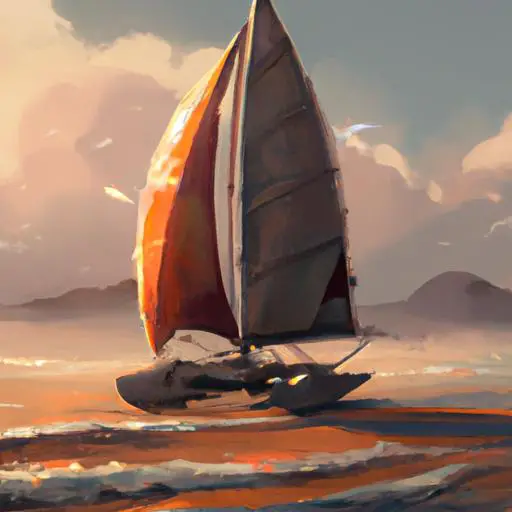
Have you ever wondered how catamarans move so fast and efficiently through the water? The answer lies in daggerboards, a unique and essential feature of these vessels.
Many sailors consider daggerboards to be one of the key advantages of sailing on a catamaran over a monohull sailboat.
If you’re curious to learn more about the science behind this nautical feature, then this article is for you.
Here, we’ll dive into the details of what daggerboards are, how they work, the benefits they offer, the types of daggerboards, and the best practices for maintenance and performance.
By the end, you’ll be an expert on the topic and be able to make an informed decision about the best type of daggerboard for your vessel.
Table of Contents
Short Answer
Daggerboards are vertical boards on a catamaran that can be raised and lowered to provide lateral resistance and stability to the boat.
When the daggerboards are lowered, they provide more stability and can help the catamaran sail closer to the wind.
When they are raised, the catamaran has less resistance and can move faster.
Daggerboards are an important part of a catamaran’s design, as they provide stability and control in difficult weather conditions.
What Are Daggerboards?
Daggerboards are a vertical fin-like structure found on a catamaran, which is a type of sailboat with two hulls of equal size.
Daggerboards are typically located on the centerline of the boat and can be raised and lowered at the skipper’s discretion.
This allows the skipper to adjust the center of effort on the boat, which in turn affects the boat’s maneuverability and control.
At the most basic level, daggerboards provide additional lift and stability to a catamaran, allowing for improved performance in light winds.
They work by creating forward thrust and lift, helping the boat move through the water more efficiently and allowing it to make tighter turns.
Daggerboards also help to reduce leeway, which is the tendency of a boat to drift sideways in the water due to the wind pushing against its sails.
By positioning the daggerboard at an angle, the skipper can reduce the amount of leeway the boat experiences, allowing it to maintain a more consistent course.
Overall, daggerboards are a key component of sailing catamarans and can have a significant impact on the performance of the boat.
With the right setup, they can make a boat faster, more maneuverable, and easier to control in a variety of conditions.
For sailors looking to get the most out of their catamaran, understanding how to use daggerboards is essential.
How Daggerboards Work

Daggerboards, also known as centerboards, are a vertical fin-like structure found on a catamaran.
They are typically located on the centerline of the boat and can be raised and lowered at the skippers discretion.
Daggerboards are designed to provide the catamaran with additional lift and stability in light wind conditions.
This helps to improve the performance of the catamaran by adjusting the center of effort on the boat, allowing for greater maneuverability and control.
When the daggerboards are lowered, they act as an underwater keel, providing additional stability and lift.
This helps the catamaran to cut through the water more efficiently, allowing it to move faster and with greater control.
The daggerboards also help to prevent the boat from drifting sideways in the wind, which can be a common issue with monohulls.
The daggerboards also help to reduce the amount of heeling (leaning) experienced when sailing upwind, making the sailing experience more comfortable and enjoyable.
When the daggerboards are raised, the catamaran will be more maneuverable and have improved performance in light wind conditions.
This is due to the reduced drag caused by the daggerboards not being in the water.
The raised daggerboards will also help to reduce the amount of heeling experienced when sailing downwind, making the sailing experience more comfortable and enjoyable.
The use of daggerboards can significantly improve the performance of a catamaran in light wind conditions and is a key component of sailing catamarans.
By raising and lowering the daggerboards, the skipper can adjust the center of effort on the boat, allowing for greater maneuverability and control.
The Benefits of Daggerboards
Daggerboards are an essential part of sailing catamarans for a number of reasons.
The most obvious benefit of having daggerboards on a catamaran is that they provide additional lift and stability, allowing for improved performance in light winds.
By raising and lowering the daggerboards, the skipper can adjust the center of effort on the boat, giving them greater control over the boat’s maneuverability.
This can be advantageous in tricky situations, such as sailing close-hauled or in tight spaces.
Additionally, daggerboards can help reduce drag in certain conditions.
By raising the daggerboards, the boat can be steered more efficiently by using the hulls to provide lift instead of the daggerboards, which can result in less drag and improved performance.
Finally, daggerboards can help improve the safety of a catamaran.
In rough seas, daggerboards can provide additional stability, helping to keep the boat upright and preventing it from capsizing or being damaged.
This can be especially beneficial when sailing in unfamiliar waters or in bad weather conditions.
In summary, daggerboards are an invaluable component of sailing catamarans.
They provide added lift and stability, can be used to adjust the center of effort on the boat, reduce drag, and improve the safety of the boat.
With all these features, it’s no wonder that daggerboards are a must-have for any serious catamaran sailor.
Types of Daggerboards

When it comes to daggerboards, there are two main types that can be found on a catamaran: retractable and fixed. Retractable daggerboards are typically made of fiberglass and can be raised and lowered at the skipper’s discretion. This allows the skipper to adjust the center of effort of the boat, providing improved maneuverability and control. Fixed daggerboards are usually made of wood or metal and are permanently mounted in the centerline of the boat. These boards provide an extra layer of stability and lift to the catamaran, allowing it to perform better in light winds.
In addition to the two main types of daggerboards, there are also some other variations that can be found on some catamarans.
A daggerboard trunk is a type of daggerboard that is mounted inside the hull of the boat.
This allows the daggerboard to be raised and lowered without having to be removed from the boat.
A foil daggerboard is a type of retractable daggerboard that is designed to provide additional lift and stability to the catamaran, allowing it to perform better in heavier winds.
There are also battened daggerboards, which are a type of fixed daggerboard that is designed to provide additional lift and stability to the catamaran.
No matter which type of daggerboard is chosen, they all provide additional lift and stability to a catamaran, allowing it to perform better in different wind conditions.
By understanding the different types of daggerboards and how they can improve a catamaran’s performance, skippers can make the most of their sailing experience.
Daggerboard Maintenance
Daggerboard maintenance is an important aspect of owning and sailing a catamaran.
It is important to keep the boards in good condition to ensure they are performing as efficiently as possible.
This means periodically checking the boards for wear and tear, making sure they are properly lubricated and free of debris, and ensuring that the fastenings and connections are secure.
Regularly inspecting the boards for signs of corrosion or damage is also important.
If damage is found, it should be addressed immediately to prevent further damage and to ensure that the boards are performing as efficiently as possible.
In addition to inspecting the boards, it is important to keep them lubricated to ensure smooth and efficient performance.
The best way to do this is by regularly applying a lubricant specifically designed for marine use.
This will help reduce friction and keep the boards in good condition for longer.
It is also important to keep the fastenings and connections of the boards secure.
This includes the bolts that attach the boards to the frame, as well as the pins and clips that hold the boards in place.
It is important to inspect these regularly for signs of wear and tear, and to replace them if necessary.
Finally, it is important to keep the boards free of debris or dirt.
This can be done by regularly rinsing the boards off with fresh water after sailing, and by using a soft brush to remove any dirt or debris that has accumulated.
By following these simple maintenance tips, you can ensure that your daggerboards are performing as efficiently as possible and that your catamaran is sailing to its full potential.
Daggerboard Upgrades

The daggerboard is a key feature on catamarans, as it provides lift and stability to the boat.
It is located on the centerline of the boat and can be raised and lowered at the skipper’s discretion.
This allows the skipper to adjust the center of effort on the boat, enabling greater maneuverability and control.
For those looking to maximize the performance of their catamaran, there are several upgrades available for the daggerboard.
A taller daggerboard can be installed to increase the lift and reduce drag, while a lower profile board can provide improved stability.
Additionally, a carbon fiber board can be used to reduce weight, further increasing the overall performance of the boat.
Another upgrade is the addition of a daggerboard trim tab, which allows for more precise control of the daggerboard.
This is especially useful in light winds, as it allows the skipper to adjust the daggerboard to maintain the optimum angle of attack.
This can significantly improve the performance of the boat in light winds.
Finally, there are a variety of shapes available for the daggerboard.
Different shapes are designed to optimize the performance of the boat in different conditions, so it is important to select the shape that best suits your needs.
In conclusion, daggerboards are a key component of sailing catamarans and can have a significant impact on the performance of the boat.
By upgrading the daggerboard, skippers can maximize the performance of their catamaran and improve its overall maneuverability and control.
Daggerboard Performance
When it comes to sailing performance, daggerboards can have a significant impact on a catamaran.
When the daggerboards are up, the center of effort is lowered, allowing the catamaran to sail in light winds with better speed and efficiency.
When the daggerboards are down, they provide additional lift and stability, allowing for improved performance in heavier winds.
The shape and size of the daggerboard also affects the performance of the catamaran.
A wide, shallow daggerboard will provide more lift in light winds, while a narrow, deep daggerboard will provide more stability in heavier winds.
As such, it is important to choose the right daggerboard for your catamaran to get the most out of it.
In addition to improving the performance of the boat, daggerboards can also help reduce drag when sailing upwind.
When sailing upwind, the daggerboards create a venturi effect, which helps reduce the drag on the boat.
This can make a huge difference in performance and can allow the catamaran to reach higher speeds in upwind conditions.
Finally, daggerboards can make a catamaran more responsive to steering.
When sailing downwind, the daggerboards can be used to help the boat turn more quickly and with greater precision.
In this way, the daggerboards can be used to make a catamaran more responsive and agile.
By adjusting the daggerboards, the skipper can adjust the center of effort on the boat, allowing for greater maneuverability and control.
Daggerboards can also help reduce drag when sailing upwind and make the catamaran more responsive to steering.
Final Thoughts
Daggerboards are a key component of sailing catamarans, and their presence has a significant impact on the performance of the boat.
They can provide additional lift and stability, allowing for improved performance in light winds, as well as greater maneuverability and control.
With the variety of daggerboard types, upgrades, and maintenance available, there is something for every boat and sailor.
Understanding how daggerboards work and the impact they can have on sailing performance can help you make the most of your catamaran.
So, take the time to consider the different options and see what daggerboards can do for you.
James Frami
At the age of 15, he and four other friends from his neighborhood constructed their first boat. He has been sailing for almost 30 years and has a wealth of knowledge that he wants to share with others.
Recent Posts
When Was Banana Boat Song Released? (HISTORICAL INSIGHTS)
The "Banana Boat Song" was released in 1956 by Harry Belafonte. This calypso-style song, also known as "Day-O," became a huge hit and remains popular to this day for its catchy tune and upbeat...
How to Make Banana Boat Smoothie King? (DELICIOUS RECIPE REVEALED)
To make a Banana Boat Smoothie King smoothie at home, start by gathering the ingredients: a ripe banana, peanut butter, chocolate protein powder, almond milk, and ice. Blend the banana, a scoop of...
- 0 No item in your cart
- The magazine
Current issue
- All the issues
- My magazines
- Technical specifications
- Multihull of the Year
- Classified Ads
- Destinations
- Online store
- All the magazines
- Subscriptions
- Accessories

Catamaran basics The daggerboards: understanding and adjusting them
Having a catamaran with daggerboards means enjoying better pointing ability than an equivalent model equipped with fixed stub keels, which are inevitably shorter. It means that you can also optimize drag, speed and even safety. Partially integrated, with foils...an inventory of the daggerboards on our boats and how to use these appendages.
Create a notification for Technical
We will keep you posted on new articles on this subject.

Published 01/04/2015
By Emmanuel van Deth
Published: may / june 2015

Choose the option that suits you best!
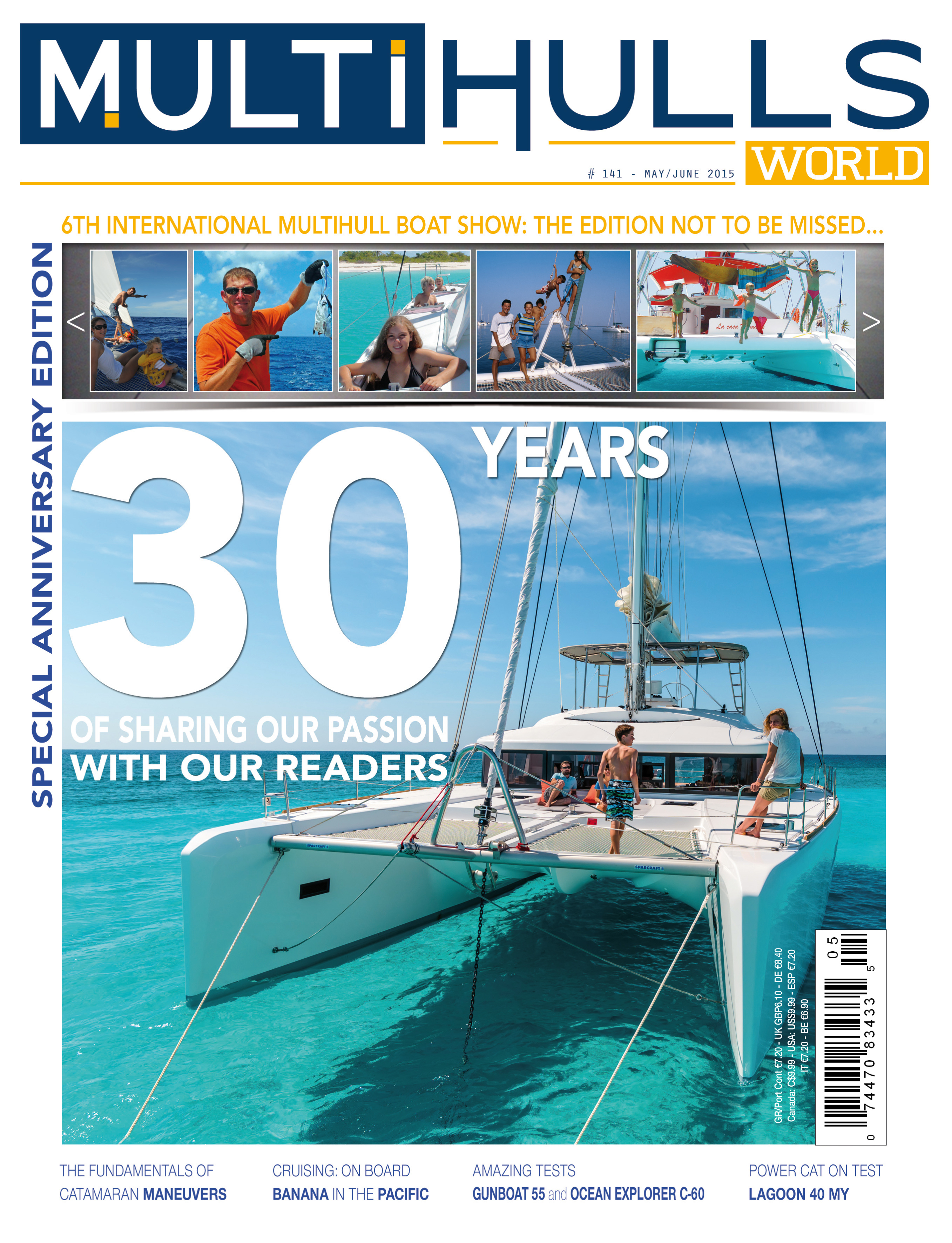
Issue #: 141
Published: May / June 2015
- Price per issue - digital : 5.40€ Digital magazine
- Access to Multihulls World digital archives Digital archives
1) All the Catanas are equipped with daggerboards. They are very long, and held structurally in their cases by the whole height of the hulls. Simple and strong, but beware of the significant windage in the raised position.
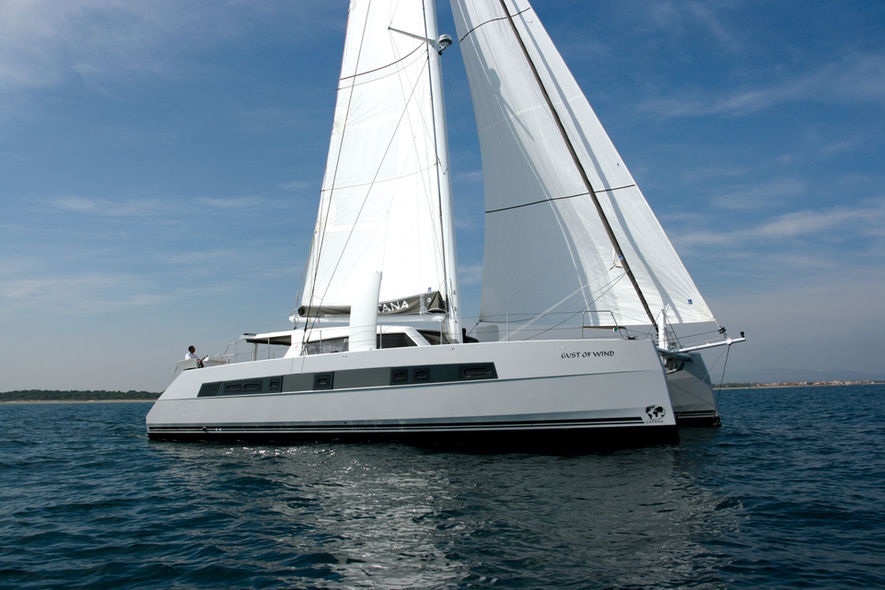
2) The latest Catana models are equipped with curved daggerboards. On the 59, the foil effect is worth 500kg at a speed of 15 knots.
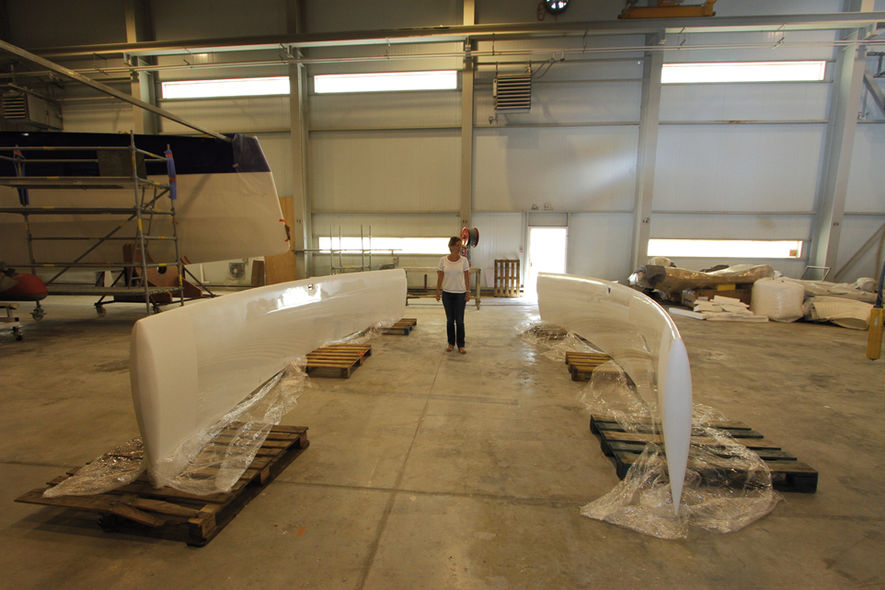
3) The latest Outremers have adopted shorter structural cases, to reduce the size of the daggerboards. Less windage in the raised position and less weight, but the construction is more complex…
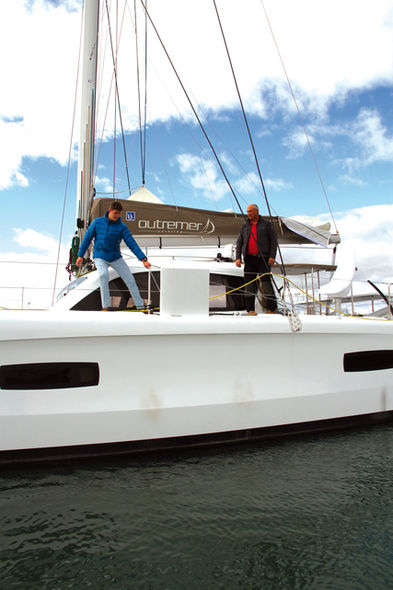
4) Numerous trimarans are also equipped with daggerboards/centerboards. They can be central and integrated into the accommodation, as aboard this Dash 750.
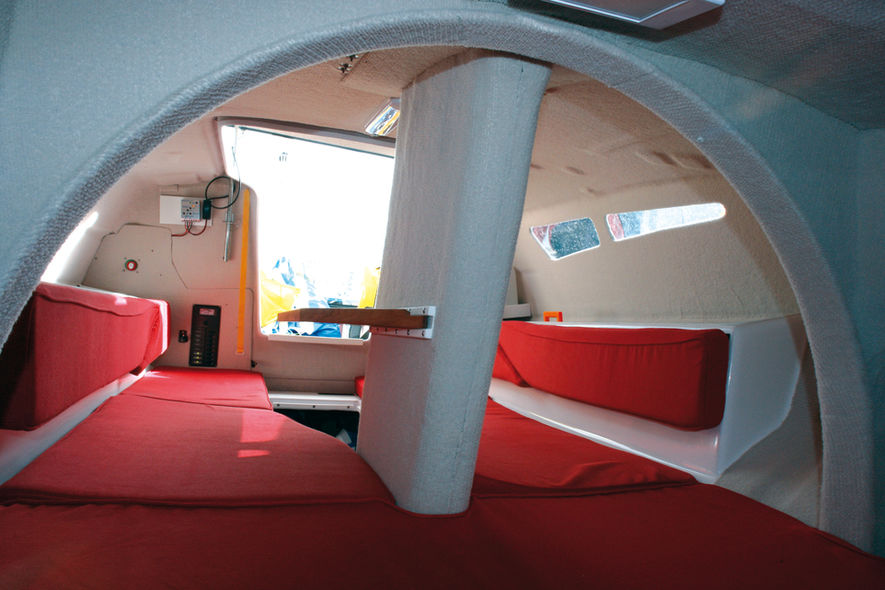
5) Other trimarans, such as the Tricat 25, are equipped with centerboards integrated into the floats.
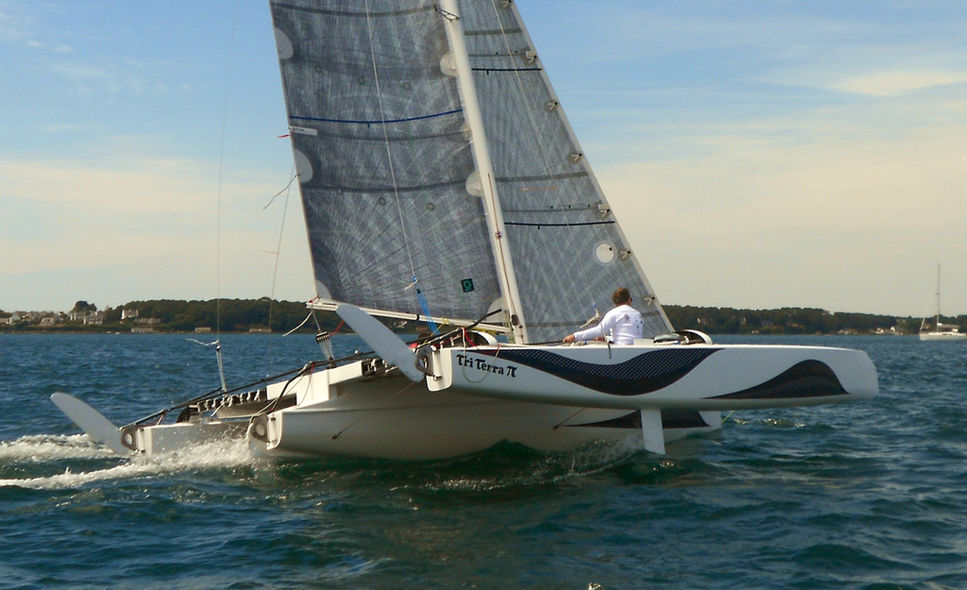
6) Builders such as Outremer provide stopper knots for the daggerboard control lines; a good way to judge the position when the daggerboard is not visible.
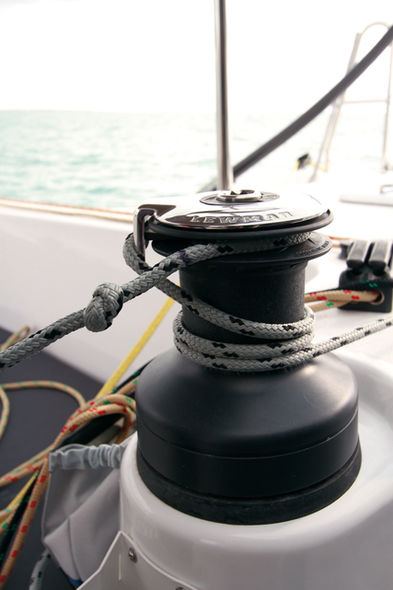
7) Once the daggerboard is out of its case, it is easier to judge: the lifelines are an excellent adjustment indicator!
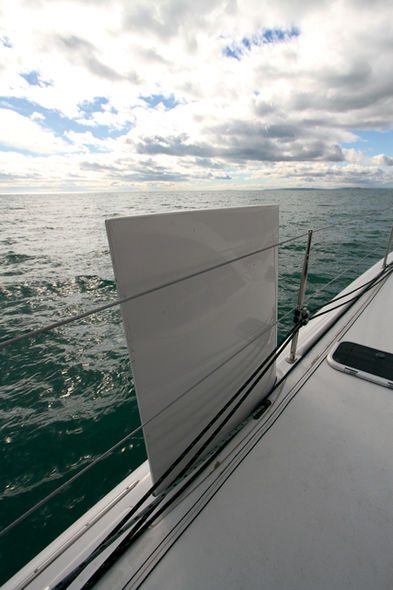
8) To windward in light weather, the daggerboards are fully lowered, to take advantage of maximum 'grip' on the water.
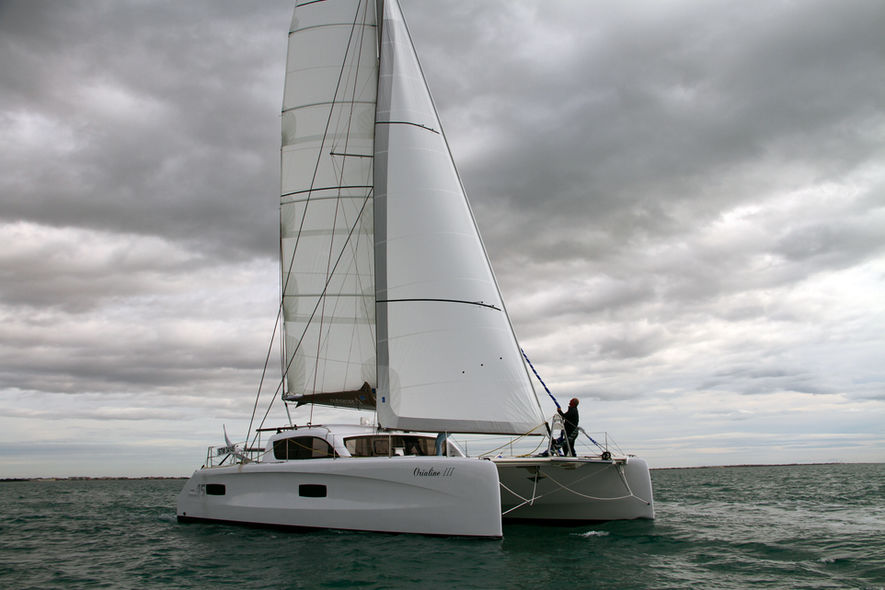
9) When the speed increases, it is worthwhile raising the windward board to optimize drag. Note: a daggerboard which moves is no use. Therefore we raise it!
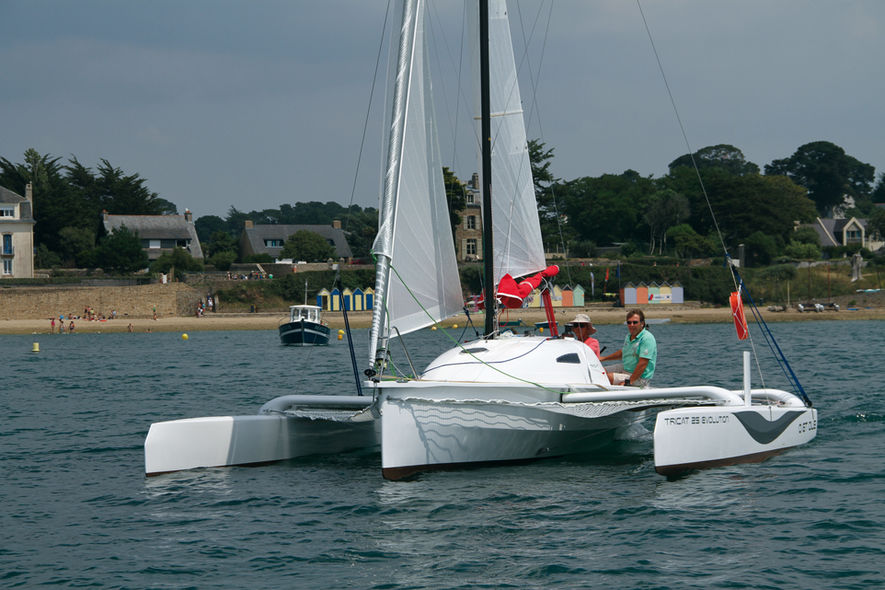
10) But for safety, it is preferable to raise the leeward appendage: in the case of a strong gust, the risk of the boat ‘tripping up’ is thus reduced. The compromise could be to raise both the daggerboards by half... It’s up to you to judge!
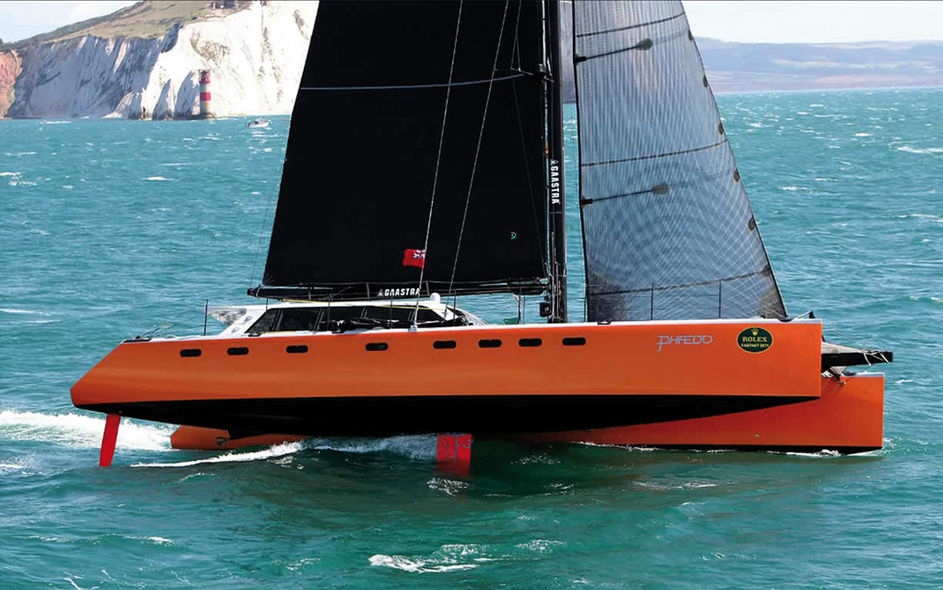
11) Downwind, the daggerboards are no longer useful, especially when the boat exceeds 10 knots... Keeping one third of the surface can however help the helmsman or the autopilot to steer a straighter course.
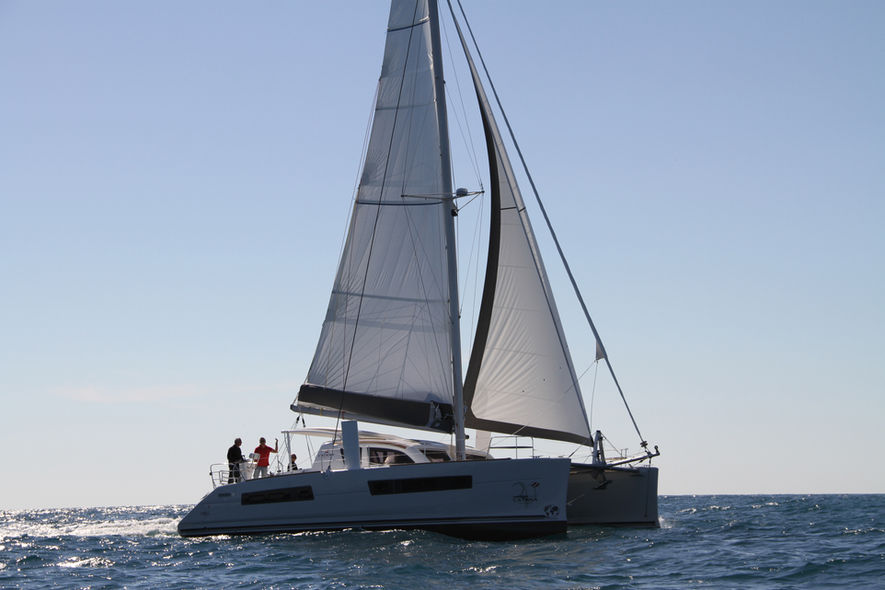
12) Heavy weather? Raise them completely so the hulls slide. On the other hand, with big seas from behind, (just like downwind in more manageable weather) it may be useful to keep a little daggerboard lowered to avoid yawing.
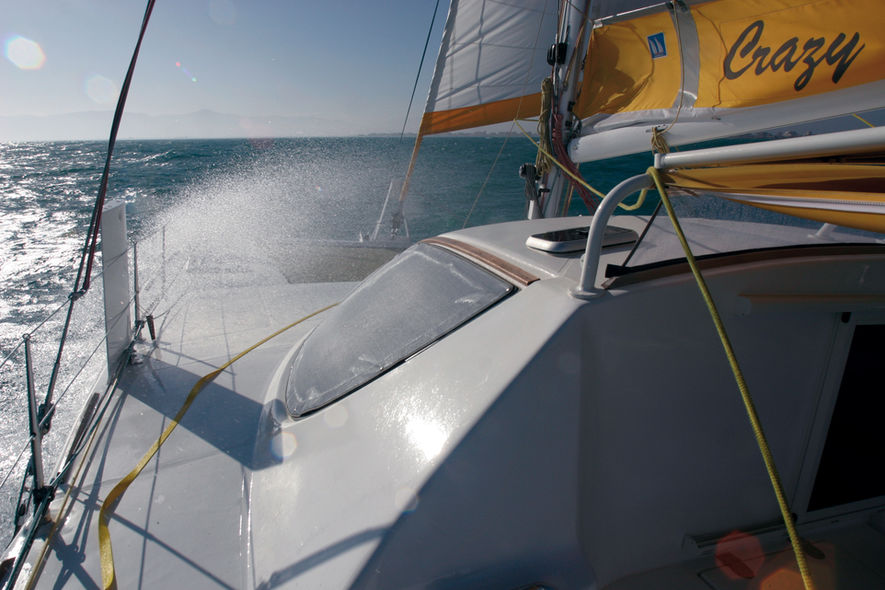
Subscribe to Multihulls World and get exclusive benefits.
Tags :
- préparation ,
- Catamaran basics
Most-read articles in the same category

Drivetrains
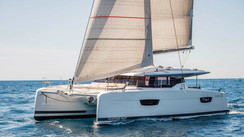
Bending on sails
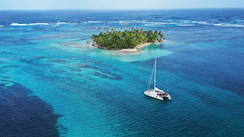
Everything you need to know about trampolines
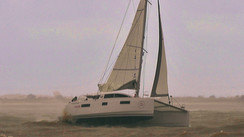
Managing heavy weather in a multihull
What readers think.
Post a comment
No comments to show.
MW #197 - Oct / Nov 2024
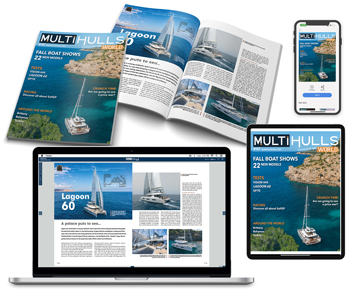
Tenders with two hulls...

Transport under sail

Hydrogen on board
Subscribe now.
The latest news from €3 / month
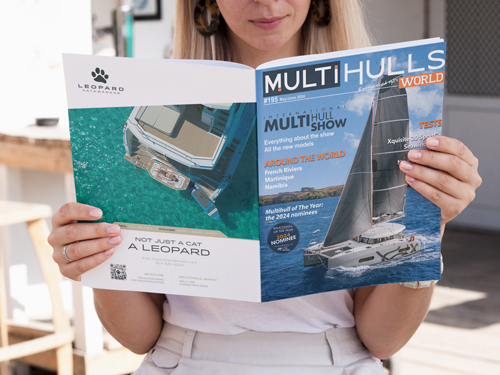
Video of the month
Our latest YouTube hit!

The Multihull of the Year
The 2024 results

Classified ads

Woods Flica 35
Bosgraaf 15m trimaran, minicat 310.

Nautitech 48 0pen Available
Vous avez ajouté " " à vos favoris., vous avez supprimé " " de vos favoris., in order to add this article to your favorites, please sign in..
- Outremer 45
- Outremer 4X
- Outremer 4.zero
- Outremer 52
- Outremer 55
- Outremer 51
- Outremer 5X
- All the Outremer Fleet
- Personalized support
- Blue Water Sailing Seminars
- Our concept
- The Outremer team
- Our commitments
- Construction principles
- Our catamaran services
- After-sales customer service & Quality control
- Offshore Connected Catamaran Maintenance
- Concierge Services
- Our owners’ stories
- FAQ – Outremer catamarans

- Brokerage: used catamarans for sale
- Privacy Policy
- Legal Notice
- Grand Large Yatching
Daggerboards: how to adjust them on your catamaran
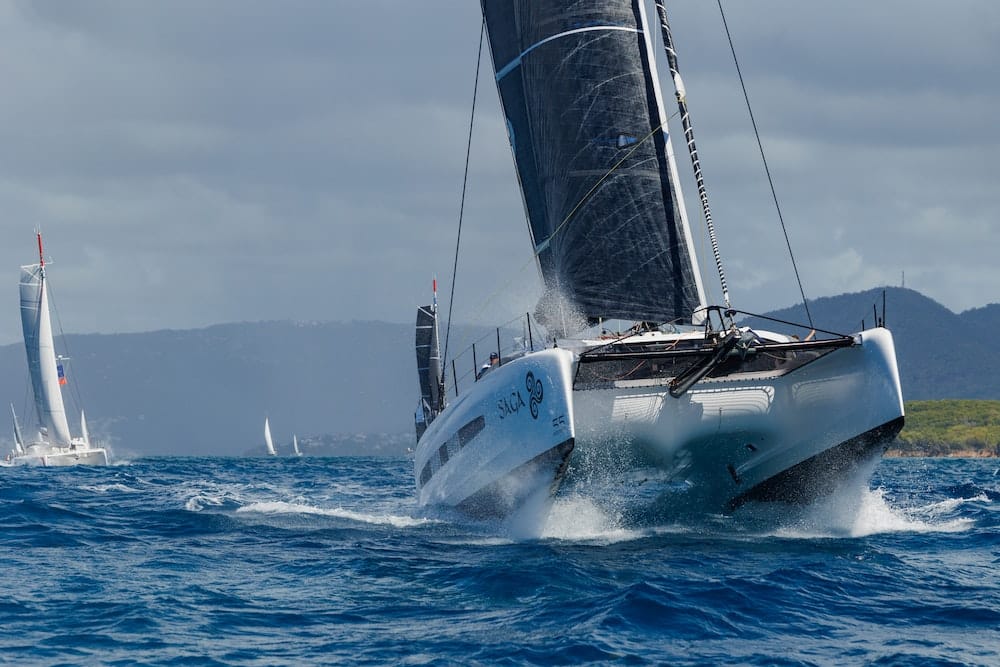
Author : Nikki Henderson
When I asked the Outremer Ladies’ community for suggestions on webinar topics, ‘Daggerboards’ was top of the list. I wasn’t surprised. I don’t think I’ve had a day out on an Outremer with prospective or current owners where daggerboards were not discussed.
It makes sense that there is a curiosity about daggerboards; using them properly is essential if you want your Outremer to perform. What is interesting though, is how confusing people find them.
One thing I’ve realised is that for some people, the issue is similar to my relationship with electronics (hate) and engineering (love). Things I cannot physically see are inherently cloaked in mystery and much more challenging for me to understand. This can be the case with daggerboards: they are hidden underwater and so are often forgotten or misunderstood.
The other reason that daggerboards can be confusing is that they affect not just the performance of a catamaran, but also the safety. Sometimes the theories contradict each other and lead to conflicting advice as to the right and wrong way to use them. In fact, there is no one ‘rule’ about daggerboards. The key, as with anything on a boat, is to understand the reasoning behind the basic daggerboard practices, so that you can make your own decision based on your own unique circumstances that you encounter at any particular time.
I hope this blog will help you build this critical foundation of understanding so that you can set sail safely and with confidence. Daggerboards – like sail trim – is a subject of continual learning. See this as step 1 in the life-long journey.
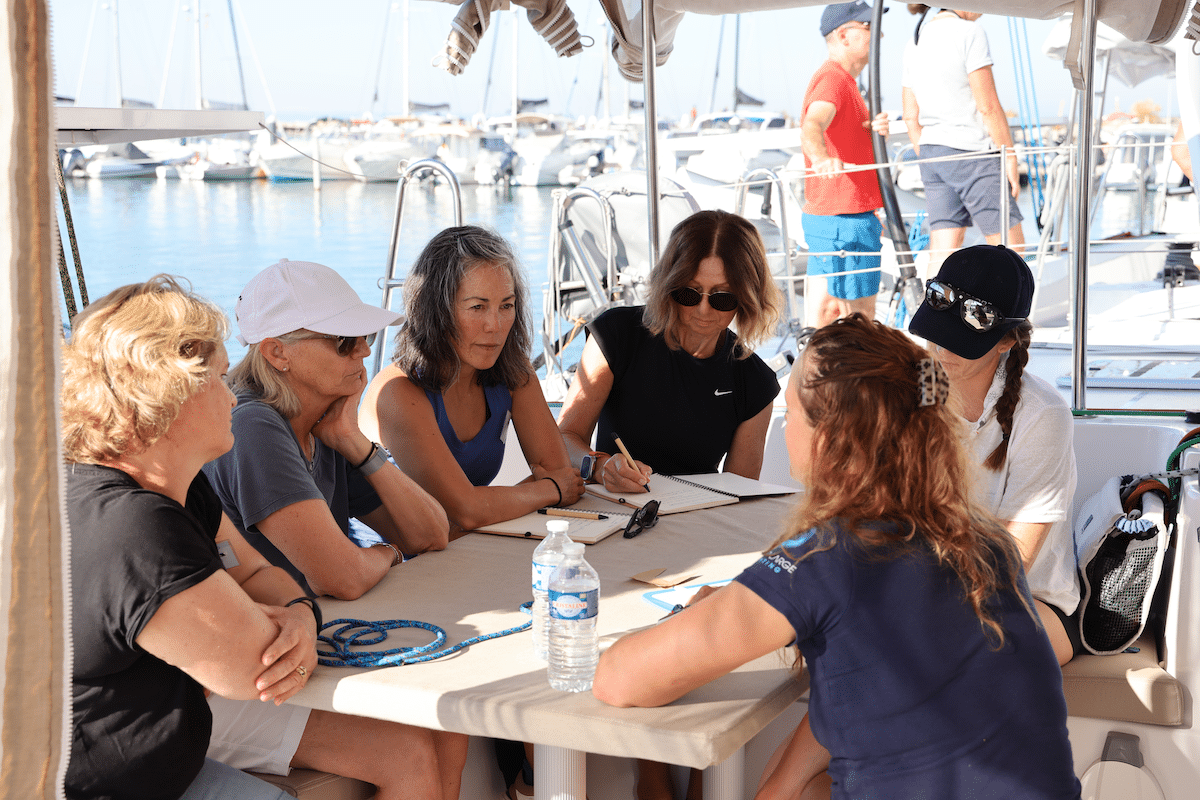
Catamaran daggerboards: how should they be adjusted for optimum sailing?
Daggerboards are best thought of as an ‘underwater sail’ – sometimes called a ‘foil’. Just as a sail above the water needs trimming – so does the sail under the water. But unlike the sail above the water, the daggerboard only has one trim option: how much of it is exposed below the hull.
When sailing upwind the daggerboards provide resistance and lift under the water to balance out the sideways effort force from the sail above the water. In more simple terms, daggerboards help the boat move forward rather than sideways when sailing upwind. Therefore, when sailing upwind, the assumed best practice is to have the daggerboards down. [UP-wind = DOWN-board]
When sailing downwind, the effort force from the sail works almost entirely in the direction you need the boat to go. Therefore, you do not need the resistance under the water from the daggerboard to help with the direction. In fact, it will probably hinder you from sailing deep downwind and slow you down. Therefore, when sailing downwind, the assumed best practice is to have the daggerboards up. [DOWN-wind = UP-board]
Generally, when sailing with wind on the beam – a good ‘go-to’ trim set up is one that is somewhere in the middle of downwind and upwind trim. Therefore, a good starting point for a beam reach would be to lift the daggerboards half-way up.
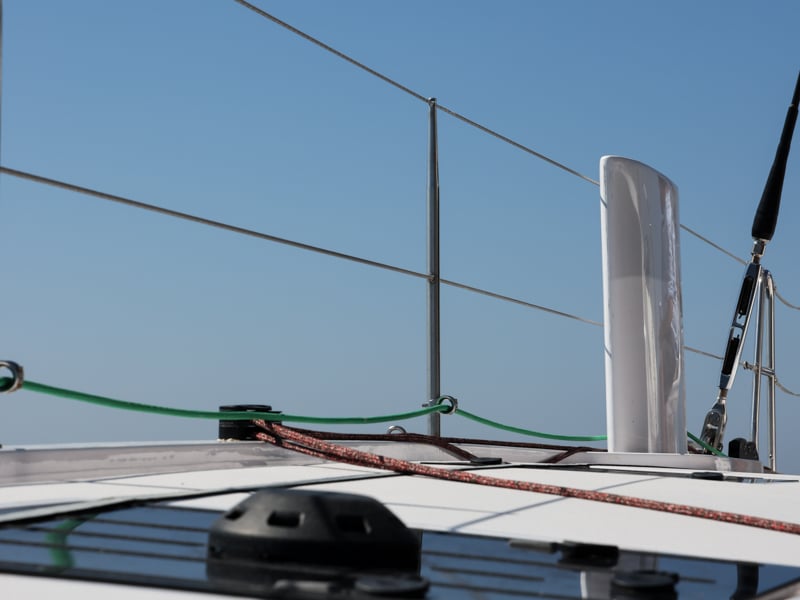
Which catamaran daggerboard for which sailing conditions?
For any competent dinghy sailors who understand daggerboards, this is the most common question as they are typically used to using only one!
An important key principle, is that a daggerboard is only effective when it is submerged in the water. Therefore, if you were sailing the boat purely for performance in a flat sea, you would always need to be trimming at least the leeward one. If the windward hull lifts slightly here and there (which it does fractionally in any substantial wind) then the windward daggerboard is not working efficiently.
Do you drop the windward board? In relation to performance, this depends on how much underwater resistance you need.
In very light winds, the standard practice is to lift the windward daggerboard all the way and only trim the leeward board. When both daggerboards are down, (for simplicity) there is now double the ‘underwater sail’ area. This would likely imbalance how much power there is from the light winds on the sail above the water, and literally ‘drag’ the boat and slow her down.
As the winds increase, there may be a time where you feel you want more underwater resistance, and you could consider lowering the windward board as well. You might find your course over ground improves. Then it was a good decision. If your speed decreases, it might be creating too much drag and you should lift it back up.
If the wind continues to increase further, it is likely you will choose to reef the main. If we return to the concept of the daggerboard being the ‘underwater sail’, if you reef the main, then consider reefing the daggerboard and lifting some up slightly with each reef you put in upwind to keep the boat balanced.
You may be wondering how such a tiny thing as a daggerboard could balance out the enormous sail area of a main sail. The answer here is that water is a much denser fluid than air, and so the daggerboard needs much less area to create the same force than it would do if it were in air.
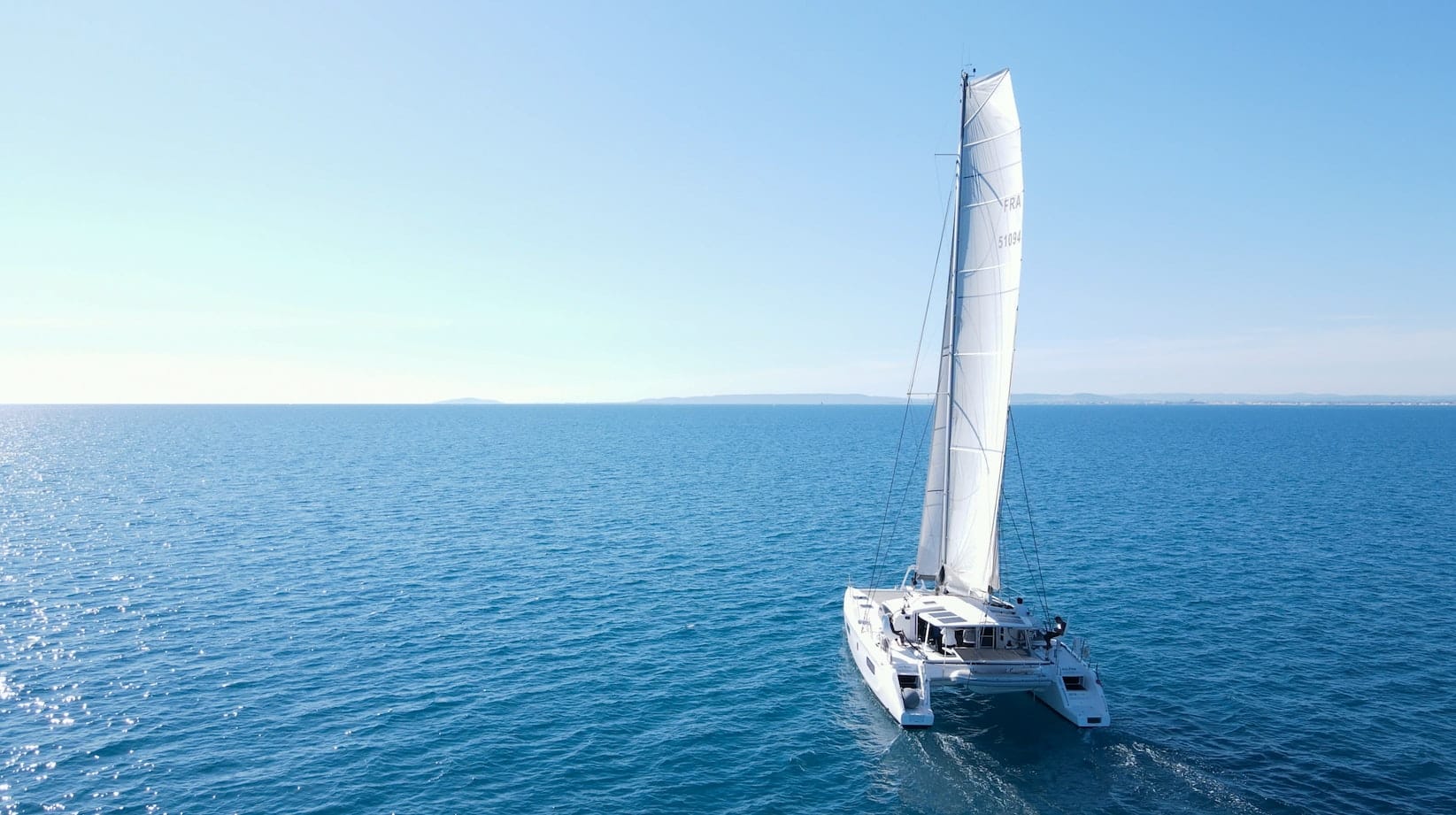
Safety at sea: adjusting daggerboards to avoid risks
This is where things start to get a little confusing.
The leeward daggerboard being down will increase the risk of ‘tripping up’. Therefore, in any significant sea state – or possible impending increase in wind/seastate such as if you are close to a mountainous shore line – where you feel that the hull is, or may, lift a lot, it is in fact safer to lift the leeward daggerboard and only use the windward one. Be aware that you will see a drop in performance as this contradicts the performance best practice of trimming the leeward board and not the windward.
The safest option entirely in very large sea states where the sea is actually tilting the boat significantly from side to side as she rolls down waves is to lift both daggerboards, so you float along waves like a raft.
‘Tripping up’ is a phrase used a lot and in fact sometimes misunderstood. To explain what it means: if there is wind/waves coming from the side of the boat and the windward hull lifts slightly in a wave, or there is a gust and the sail powers the boat forward – the leeward hull can ‘dig in’ to a wave and trip the boat up. The best way to imagine this is imagine getting one of your shoelaces on one of your feet stuck but the rest of your body is still walking. You will fall over. Same with the boat.
A converse argument to lifting the daggerboards up, is that dropping both of them will protect the underside of the boat – from grounding, or from hitting a submerged object. Having both daggerboards partially down can protect the propellor. Having them at ‘deck level’ can protect the rudder. In other words, if you hit something then it will hit the daggerboard before the more fragile underwater equipment.
Another argument against lifting the daggerboards entirely, is that with no daggerboards, your rudder is doing all the ‘resistance-work’. It is hard to believe, but it also acts as a very tiny underwater sail too. There will be a huge load on the rudder with no daggerboard at all and this risk is probably not worth the gain in speed on a long downwind ocean crossing. One way to spot if the rudder is working too hard is just look at your autopilot rudder angle – if it’s maxing out and having to work very hard to keep the boat going straight then you probably have too much sideways slip. It’s a bit like the boat is sailing on an ice rink. In that case, I’d recommend putting both of them down a touch. This will benefit both the ruder and the autopilot (therefore power consumption).
(Read our Safe Sailing article to learn more about safety on board)
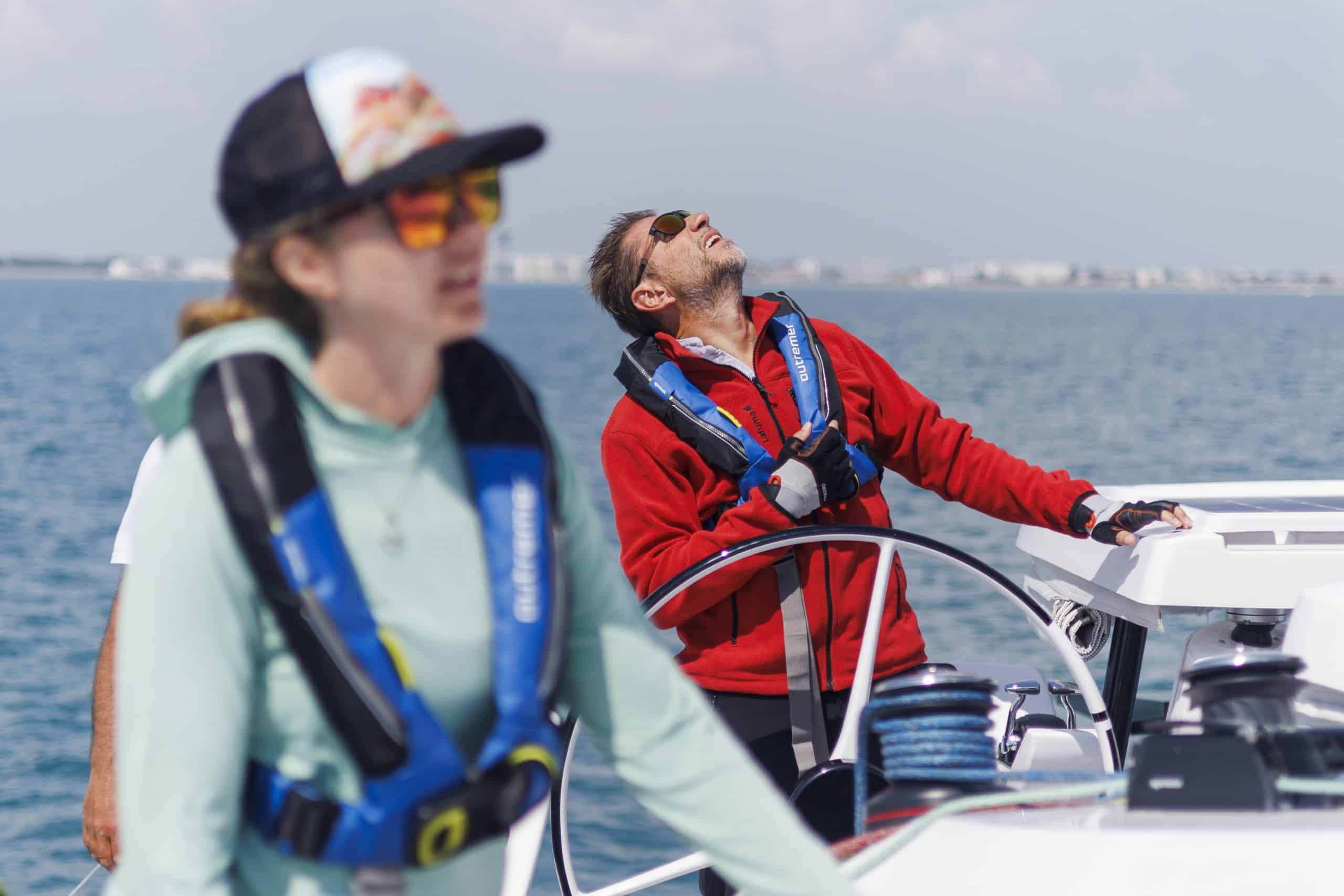
Using daggerboards is a balancing act! Boat weight, weight distribution, sail area, wind strength, sea state, sail trim are all things that effect the decision for how to use the daggerboards: how much daggerboard to use and which one (or both) to use. This is why it’s not an exact ‘one size fits all’ rule and anyone who tells you so is probably oversimplifying it which could lead to a dangerous sitaution. But start using them and see how the boat feels. The beauty of buying an Outremer is that if you keep her lightweight and trimmed well, then she will talk to you and tell you what feels good. Don’t believe me? Try sailing a brand-new Outremer out of the factory before she has anything on – then compare it to one with four peoples’ life belongings on – and you will see what I mean. 😉
Continue navigation
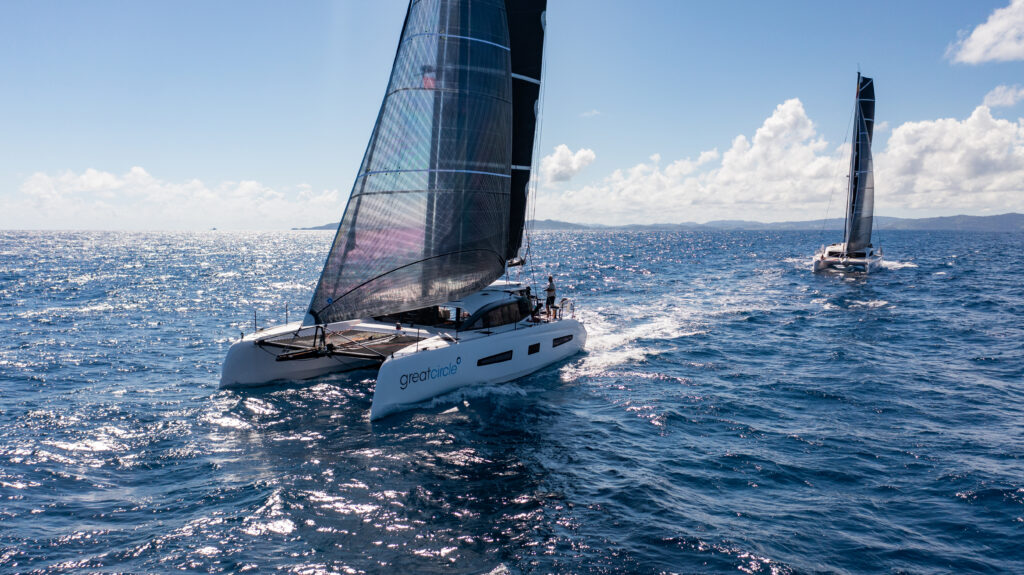
40.000 miles and 3 years to get from La Grande Motte to La Grande Motte
Marijke and Mark sail the Outremer 55 Great Circle.
Since its launch in 2021, the boat has sailed around the world with the GLYWO 500.
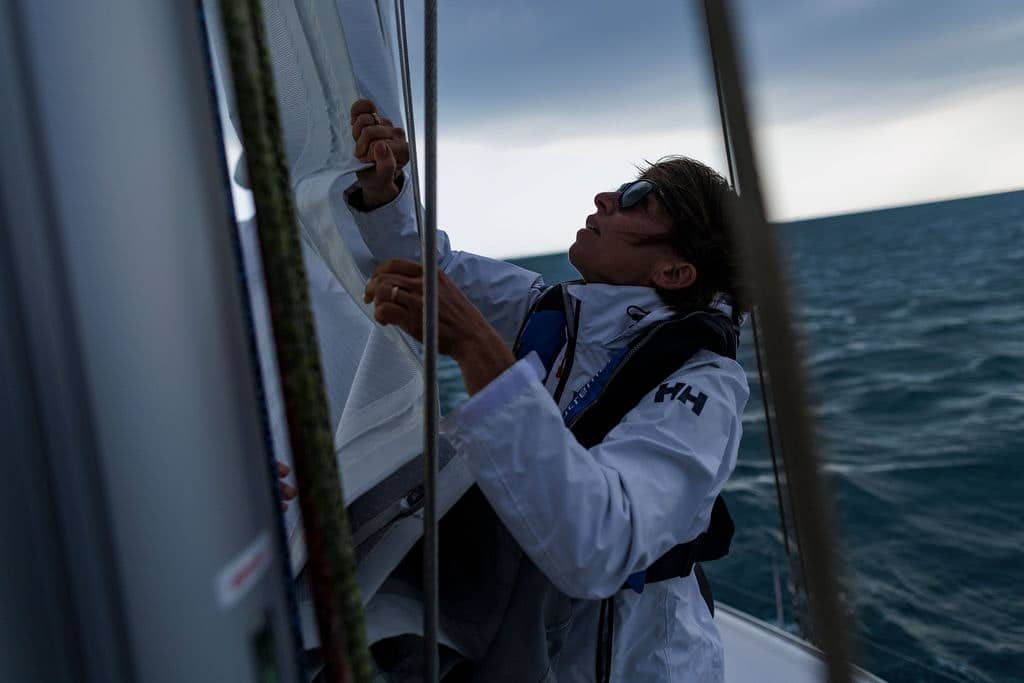
Setting off on a catamaran with the best sailing weather
When you’re getting ready to set off on a sailing trip, it’s vital to find out about the seasons and weather phenomena in your chosen sailing area. Even before choosing your cruising destination or travel itinerary, or even selecting your yacht!
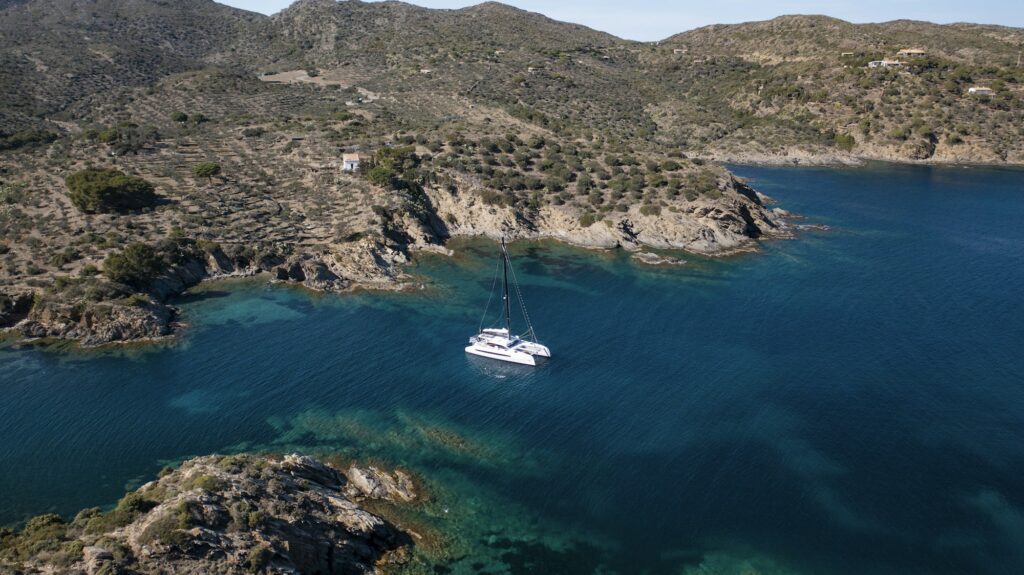
Catamaran VS Monohull: what should you choose to sail around the world?
Sailing around the world is a dream come true: you discover the world to the rhythm of the wind and the stopovers, exploring new destinations every day as you sail. If you’re just starting to read this article, you’re probably nurturing this project. Are you planning to sail around the globe? Then the choice of ship for your next voyage is crucial.

Centerboard VS Daggerboard The Differences Explained
As an Amazon Associate, we earn from qualifying purchases. We may also earn commissions if you purchase products from other retailers after clicking on a link from our site.
Sailing life entails many words that at first make no sense; in this article, I will explain the difference between two types of underwater foils, centerboards and daggerboards.
On a sailboat, the difference between a daggerboard and a centerboard is how they are moved into position. A daggerboard is lifted and raised vertically (up and down) through a slot in the hull; a centerboard, on the other hand, pivots or swings into place.
That was the short answer. There are many more commonalities and differences worth discussing, such as the differences in performance and what happens if your daggerboard hits a reef? Will it break your hull?
Keep reading to understand all you need to know about daggerboards and centerboards!
Table of Contents
Centerboard
The centerboard is mounted horizontally on a rotating bolt at the foremost part of the foil (keep reading to understand what a foil is). It folds into a comparatively much longer slot in the hull than a daggerboard.
A centerboard comes in many different shapes and sizes, it can be combined with an already existing keel, or it can be larger and be more of a stand-alone type.
How is a centerboard operated?
The centerboard is operated through a lifting line fastened at the end of the centerboard fin(board); this line is manipulated either by hand or by a winch and, once fully retracted, will be tied to a cleat.
Daggerboard
The daggerboard, on the other hand, is mounted vertically inside a sliding slot in the hull, it gets it name from the movement, much like the stabbing motion of a dagger.
The board is stopped from moving too far and falling out because the top part is wider than the lower part.
How is a daggerboard operated?
It is manipulated much like the centerboard, through a lifting line and a winch. But instead of being attached through a bolt and swung into position, it is lowered down into place.
What are the differences?
Performance.
Since the differences mainly lie in the way of deployment, there are not that many big difference, but some smaller once worth noticing are;
The daggerboard doesnt have to be either fully up or fully down; this means the sailor can adjust the depth and effects to his or her needs. To low and there will be unnecessary drag, to high and there will be too little lift and too much drift to windward.
On the other hand, the centerboard pivots into position and is only really efficient as a foil once fully deployed.
Reducing the draft of a boat is very important if you want to sail in very shallow waters such as the Bahamas or if you want to beach your cat.
What is beaching a cat?
Once retracted, there is also a decreased chance of getting stuck or tangled up in a fishing net or other semi-floating objects and sometimes hard to see.
On boats where the keel is the lowest point on the boat, the propeller will be protected, but on ships where the center or daggerboard is the lowest spot, then retracting it will make it vulnerable to damage from whales, fishing nets, or coral. You will also not be able to beach your cat since the weight of the ship will be loaded on top of your prop shaft and most certainly will break it.
Once the boards are in a fully lifted position, there is an argument to be made that the centerboard, which has a much larger slot, will have higher drag. This is true, but only if the slot is poorly design and not hydrodynamically smooth, causing underwater turbulence.
A well-designed centerboard should be able to reduce the amount of drag to the same as a daggerboard.
What are the similarities?
Both systems can be mounted in pairs and at an angle; this makes the boards work much as an airplane wing does. Once the water starts passing around it, it will create higher water speeds on the upper side, lowering the pressure and increasing lift.
This makes for less underwater surface, decreases drag, increases speed, and fuel efficiency.
One issue often discussed on forums and with boat people is that a centerboard is safer since if an underwater object hits it, it will fold back into its slot, and no damage will be done. This is true to a degree but worthy of some explanation.
Firstly this is mainly a theoretical argument since an object is not certain to hit the board from straight on; this means that the idea of folding is no longer possible. The next thing to understand is that daggerboards are made to break; this is a safety aspect and makes sure that the hulls stay intact and that the boat will stay afloat.
This is similar to modern mini keels on catamarans; they too are constructed to detach if hit hard enough, the keels fall off, but the hull stays intact.
Both systems offer a risk of getting stuck; some say this is a bigger issue with daggerboards, and they more often fail than the centerboard style. This is not something that I have been able to confirm through any data, and looking at the design of newer daggerboards; there is no real reason to think that this should be the case.
There are many different systems on a sailboat, and everything that can move will sooner or later stop moving due to rust or being filled up with salt and sand. So will too these boards; this means extra time for maintenance and extra money to be spent keeping the systems in good shape.
Compared to each other many would argue that the centerboard is a somewhat simpler system and that they need less maintenance; I would say it is more up to the specific design than whether or not it is a centerboard.
Catamarans and Monohulls
The basic function of a foil is the same whether you’re on a catamaran or a monohull, although some aspect is specific for a cat.
A catamaran will always have two boards; these can be used together or separately. Since a catamaran behaves very differently in big seas than a monohull, the use of foils, especially during heavy weather, is essential to understand if wanting to stay safe.
One situation when catamarans can capsize is while being pushed horizontally by a big breaking wave hitting it from the side. If both boards are down, this will decrease the possible sliding motion and therefore increase the likelihood of capsizing.
This is a complex issue and if you want to undestand capsizing in detail i suggest you read this article;
Why do catamarans capsize
Owner of CatamaranFreedom.com. A minimalist that has lived in a caravan in Sweden, 35ft Monohull in the Bahamas, and right now in his self-built Van. He just started the next adventure, to circumnavigate the world on a Catamaran!

Leave a Reply Cancel reply
Your email address will not be published. Required fields are marked *
Save my name and email in this browser for the next time I comment.
Recent Posts
Must-Have Boat Gear for Catamaran Sailors!
Sailing is probably the most gear-intensive activity I've ever done; there are so many decisions to be made about what gear to buy now, for tomorrow, and what to definitely never buy. The gear on...
6 Best Trailerable Trimarans For Bluewater and Coastal Sailing
Having a boat costs a lot of money, even when you are not using it, marina fees, etc. And once it is in the water most sailors never go very far from their "home marina" and sailing will be somewhat...
- DESIGN TOPICS
- Daggerboards vs. Fixed Keels
Daggerboards or Mini Keels for Catamarans?
Comparing fixed keels and daggerboards.
Fin keels, fixed keels, minikeels, skegs. Call them what you like, we know what you’re talking about. Choosing between fixed keels and daggerboards is probably one of the most debated options for a cruising boat and a difficult decision for a first time boat builder or purchaser. There’s no doubt high aspect ratio daggers give the optimum lift to windward and quicker tacking, but how significant is the downside of going to fixed keels, and are there significant disadvantages to living with daggerboards?
Fixed keels often get a bad rap. But it’s largely because there’s a lot of fixed keels out there that aren’t well designed. Poor section shapes and too shallow are the main problems.
Not all fixed keels are created equal, and because fixed keels by nature have a lower aspect ratio than a daggerboard, the foil section and planform (side view) selection are critical to minimise the tip loss - or the flow that runs under the keel and reduces the lift which provides windward ability. Obviously a relatively deep keel of moderate length will develop more lift than a long shallow keel, and this can be further improved by fitting an end plate to the base of the keel.
Construction Time and Cost
The dagger and dagger case combination probably take a little longer to manufacture and install and you will need to use carbon in the spar caps, but otherwise there is no significant difference in materials costs.
However for daggerboards you do need to pay particular attention to the hull to dagger case bonding areas which need to be de-cored and strongly reinforced. Also there is the additional hardware involved in the controls required for daggerboards, and a little extra deck clutter.
Asymmetric boards? These are totally inappropriate on a cruising cat in my view. With asymmetric boards the windward boards should ideally be lifted each time you tack or it will be causing drag. This means each board needs to be larger to get the same lift. An unnecessary complication for a minimal difference in performance on a cruising boat.
Building Implications
The keels are at a disadvantage here in that the building space will require 500mm or more of roof height if they are attached to the hulls at the start of the project. This also means more climbing and more scaffolding to work on the boat. One option here is to fit the keels and glass tape them to the hulls after the boat is extracted from the building space and lifted to the required height.
Performance Comparison
The difference in windward performance between fixed keels and daggerboards on cruising cats varies depending on the conditions. In very light airs the daggerboards have a clear advantage, providing reduced wetted area and greater lift at angles of attack where a large percentage of the fixed keel’s area is likely to be suffering from flow separation. The boat with a fixed keel is likely to point nearly as high as one with dagger boards, but will lose ground though increased leeway.
As the wind strength increases the fixed keels will typically operate much more efficiently and from personal experience the difference in performance between two similar cats -one with efficient fixed keels, the other with daggers - is minimal in 10 knots or more of breeze, and negligible in 15 knots and above.
The boat with the fixed keel might be expected to suffer more friction drag downwind due to increased wetted area, but once again from personal experience this disadvantage is only clearly evident in light airs.
Other Factors
Most of the cruising boats I have designed have been fitted with fixed keels - even though an option for dagger boards is provided in the plans. This is mainly because of the advantage of being able to dry the boat out on the beach with the hull bottom easily accessible for cleaning, but also for the protection the keel provides to the rudder and sail drive leg.
These factors don’t rule out dagger boards - most boats will sit on the hull bottom and the rudder without suffering damage to the rudder stock - however I do recommend that the dagger board, if fitted has a restraining strap or line which can be released to prevent the board being raised above the height of the rudder tip or sail drive leg when sailing.
Keep in mind that with fixed keels you will have less draft than a boat sailing with the boards fully down so the chance of a grounding is increased with daggers, and because the fixed keel has an angled entry profile it is less subject to damage from a sudden collision. Dagger boards take very high loadings and cedar and glass construction is generally more forgiving than amateur composite construction.
Daggerboards can be noisy inside the case, both when raised or lowered. This problem can be minimised with soft bearings at the top and bottom inside the case (synthetic grass or carpet) but is not always easy to completely avoid.
On a boat any bigger than about ten or eleven metres the daggerboards are a big chunk of stuff and can be difficult to raise and remove from the boat for maintenance.
We sometimes hear the argument that fixed keels could cause the boat to trip and capsize sideways in a sea. In steep seas you're most likely to be running (possibly with a drogue) or laying to a sea anchor.
I've never heard of a cat tripping sideways over its' keels but please enlighten me if this has been the case.
Making the Decision
I generally recommend that daggerboards are a worthwhile investment if the owner has a preference for sailing to windward rather than motoring or waiting for a favourable breeze, and if the boat is going to be kept light enough to have a power to weight ratio that will do justice to the dagger board configuration.
As a rough guide I would suggest that a 40’ cat which had a sailing weight of six tonnes or less would benefit from dagger boards, while a relatively heavy cruising cat would gain very little benefit from the more efficient foils. On a 50’ cat the cut off point is probably about 10.5 to 11 tonnes.
Dagger boards should be at least partially raised when reaching at high speed, and the need to raise and lower the board at various times is an added complication that a lot of cruising people would prefer not to have.
Daggerboards do break from time to time. Until now I have not heard of a cat having a structural problem with fixed keels, except for one that was washed sideways across a coral reef and then mercilessly pounded by waves. In that case the keels may have provided some additional safety.
Generally speaking cruising cats with fixed keels are probably easier to resell than cats with daggerboards. If you’re finding it difficult to make the decision and you're not interested in racing then it’s likely that fixed keels are right for you.
- Scroll to top
Did You Know That We Offer Contract to Closing Services? Click Here to Find Out More.
Need Marine Financing? Apply Here With Our Partner, First Approval Source
- Catamaran Interviews
- Catamaran Reviews
- Buying Advice
- Selling Advice
- Woods Design Advice
- Admiral 38
- Admiral 40
- Admiral 50
- Americat 3014
- Antares 44
- Aquila 44
- Aquila 48 Power Catamaran
- Aventura 37
- Balance 442
- Balance 482
- Balance 526
- Bali 4.0
- Bali 4.1
- Bali 4.2
- Bali 4.3
- Bali 4.4
- Bali 4.5
- Bali 4.6
- Bali 4.8
- Bali 40 Catspace
- Bali 5.4
- Bali Catsmart
- Beneteau Blue II
- Broadblue 346
- Broadblue 38 Prestige
- Broadblue 385
- Broadblue 435
- Broadblue 46
- Rapier 400
- Rapier 550
- Catalac 10M
- Catalac 11M
- Catalac 12M
- Catalac 8M
- Catalac 900
- Catalac 9M
- Catana 381
- Catana 39
- Catana 401
- Catana 40S
- Catana 411
- Catana 42
- Catana 42 S
- Catana 431
- Catana 44
- Catana 471
- Catana 50
- Catana 521
- Catana 531
- Catana 55
- Catana 581
- Catana 65
- Catathai 44
- Chris White
- Chris White 48 Voyager
- Chris White 55
- Condor 40
- Contour 34
- Corsair F28 R
- De Villiers
- Dean 365
- Dean 400
- Dean 440
- Dean 500
- Dix DH550
- Dolphin 380
- Dolphin 460
- Edel 35
- Endeavour 30
- Endeavour 35 Victory
- Endeavour 36
- Endeavour 44
- Endeavour 44 TrawlerCat
- Endeavour 50 Pilothouse Trawler
- Excess 11
- Excess 15
- F-41
- Fastback 43
- Fastcat 445
- Fisher 28
- Fisher 32
- Fortuna 36 Island Spirit
- Fortuna 401 Island Spirit
- Fountaine Pajot
- FP 32 Maldives
- FP 35 Tobago
- FP 36 Mahe
- FP 37 Antigua
- FP 38 Athena
- FP 39 Fidji
- FP 40 Isla
- FP 40 Lavezzi
- FP 40 Lucia
- FP 40 MY
- FP 40 Summerland MY
- FP 41 Lipari
- FP 42 Astrea
- FP 42 Venezia
- FP 43 Belize
- FP 44 Helia
- FP 44 Orana
- FP 45 Elba
- FP 46 Bahia
- FP 46 Casamance
- FP 48 Salina
- FP 50 Saba
- FP 56 Marquises
- FP 57 Sanya
- FP 58 Ipanema
- FP 60 Eleuthera
- FP Saona 47
- Fusion 40
- Gemini 105
- Gemini 3000
- Gemini 3200
- Gemini 3400
- Gemini Freestyle 37
- Gemini Freestyle 399 Power
- Gemini Legacy 35
- Grainger 420 Mystery Cove
- Gunboat 55
- Hirondelle 7M
- HopYacht 30
- Island Packet
- Island Packet Cat 35
- Kennex 420
- Knysna 440
- Knysna 480
- Knysna 500
- Knysna 550
- Lagoon 35
- Lagoon 37 TPI
- Lagoon 380
- Lagoon 39
- Lagoon 40
- Lagoon 400
- Lagoon 410
- Lagoon 42
- Lagoon 42 TPI
- Lagoon 420
- Lagoon 421
- Lagoon 43 PC
- Lagoon 44 Power Cat
- Lagoon 440
- Lagoon 450
- Lagoon 46
- Lagoon 470
- Lagoon 50
- Lagoon 500
- Lagoon 52F
- Lagoon 55
- Lagoon 560
- Lagoon 570
- Lagoon 620
- Lagoon Seventy 8
- Lagoon Sixty 7
- Leeuwin 42
- Leopard 38
- Leopard 39
- Leopard 39 PowerCat
- Leopard 40
- Leopard 42
- Leopard 43
- Leopard 44
- Leopard 45
- Leopard 45 Classic
- Leopard 46
- Leopard 46 Lion PowerCat
- Leopard 47
- Leopard 47 PowerCat
- Leopard 48
- Leopard 50
- Leopard 51 PowerCat
- Leopard 53 PowerCat
- Leopard 58
- Lidgard 73 Executive
- Looping 50
- Maine Cat 30
- Maine Cat 38
- Maine Cat 41
- Manta 40
- Manta 42
- Matrix 450 Vision
- Matrix 760 Silhouette
- Maverick 400
- Maverick 420
- Maverick 440
- Moxie 61
- Nautitech 40
- Nautitech 40 Open
- Nautitech 44 Open
- Nautitech 442
- Nautitech 46 Open
- Nautitech 47
- Nautitech 47 Power
- Nautitech 475
- Nautitech 65
- Neel 45
- Neel 47
- Outremer 40
- Outremer 45
- Outremer 50 Standard
- Outremer 55
- Outremer 5X
- PDQ 32
- PDQ 36
- PDQ 42 Antares
- Privilege 37
- Privilege 39
- Privilege 42
- Privilege 43
- Privilege 435
- Privilege 45
- Privilege 465
- Privilege 48 Transcat
- Privilege 482
- Privilege 495
- Privilege 510
- Privilege 65
- Privilege Serie 5
- Prout 31 Quest
- Prout 33 Quest
- Prout 34 Event
- Prout 35 Snowgoose
- Prout 37 Snowgoose
- Prout 37 Snowgoose Elite
- Prout 38
- Prout 38 Manta
- Prout 39 Escale
- Prout 45
- Prout 46
- Royal Cape 45
- Royal Cape 500 Majestic
- Royal Cape 530 Majestic
- Sailcraft 30 Iroquois
- Sailcraft 32 Comanche
- Sailcraft 35 Cherokee
- Sailcraft 41 Apache
- Sailcraft 44 Apache
- Scape 39
- Wildcat 350
- Seacart 30
- Seawind 1000
- Seawind 1160
- Seawind 1200
- Seawind 1260
- Seawind 1600
- Simpson 48
- Solaris 36 Sunrise
- Solaris 36 Sunstar
- Solaris 42
- St Francis 44
- St Francis 48
- St Francis 50
- Stealth 11.8
- Sunreef 60
- Sunreef 62
- Sunreef 70
- Sunreef 74C
- Sunreef 82 DD
- Sunreef 88 DD
- Switch 51
- Switch 55
- TRT 1200
- Heavenly Twins 26
- Ocean Twins 38
- Vaan R5
- Vision 444
- Voyage 380 Maxim
- Voyage 400 Norseman
- Voyage 430 Norseman
- Voyage 440
- Voyage 450 Cabriolet
- Voyage 47 Mayotte
- Voyage 480
- Voyage 500
- Voyage 580
- Voyage 590
- Kronos 45
- Wharram 38 Tiki
- AMI 320 Renaissance
- Woods 22 Wizard
- Woods 35 Banshee
- Woods 35 Flica
- Woods 36 Scylla
- Woods 36 Vardo
- Woods 38 Transit
- Woods 40 Meander
- Xquisite X5
- Xquisite X5+
Catamaran Daggerboards and Keels – Woods Interview # 9
- Post author By Diane Selkirk
- Post date March 27, 2021
- No Comments on Catamaran Daggerboards and Keels – Woods Interview # 9

I am with Richard Woods, and we are talking about catamarans. He’s a legendary catamaran designer and experienced catamaran sailor of many different designs. This is one of several interviews we’re having on different topics. Today, we’re talking about daggerboards versus keels. Richard will tell us a little bit about how daggerboards work, how keels work, and what some of the benefits of each are.
For more from Richard Woods, please go to his website .
Richard, can you start off with what dagger boards and keels do for a boat?
There’s the three basic ways of preventing leeway, which is what you’re going to be doing with a multihull. On a monohull you’ve got the keel. Essentially, it’s for stability to balance the heeling, to stop the boat heeling too much. You don’t have that as a problem on a multihull. You are just trying to stop leeway.
You can do it either with using the hull shape, which would be like a Catalac or Wharram catamaran. Then the next would be to have keels. The third would be to have daggerboards.

You could essentially say that a catamaran with keels is a bit like a long-keel monohull, and the daggerboard catamaran is a fin keel monohull in more terms. I think we all know and all agree that the best sailing boats are going to be the one with fin keels. Then progressively a long-keel boat or keel or one with low aspect-ratio keels on the catamaran, that would be the next best. Then the one relying just on hull shape, whether it’s a test barge or a Catalac is going to be the the least good.

There’s two things on that. One is that the daggerboard prevents leeway better, but also prevention of or reduction of pitching, increasing potential top speed. You want to have buoyancy at the ends of the boat and not in the middle. You imagine a diamond shape sailing to windward, and it pitches up and down, up and down, and you end up hobby-horsing. Whereas a boat with fuller ends isn’t going to do that. Unfortunately, the thing with their keels, is that the buoyancy is more in the middle of the boat.

So there’s the two factors: one is the the sea kindliness of having daggerboards, and the other is the better performance.
A daggerboarded boat is always better, but it does have some disadvantages. The main one is that if you want to beach your boat or dry it out. To me, that’s always a major advantage of a multihull. You got to be able to have lifting rudders, and essentially, you don’t want your propeller to be the deepest part of the boat, or if you’ve got an inboard engine.
The daggerboarded boats work really well when you’ve got outboard engines and when you’ve got tiller steering, because it makes it easier to get the rudders. It is still possible on bigger boats and you can also have a bit of a compromise of having a small keel, and then the daggerboard. Or you can have like your boat was, which had daggerboards in the lead hull, so you didn’t need to lift the rudders. The rudders are still higher than the bottom of the keel.

Although there’s a lot of places in the world where you don’t have to beach the boat, the most obvious to say: the Great Lakes in North America, Florida, the Bahamas, most of the Caribbean in fact, you don’t have to. The Mediterranean. They don’t have tides and so you’re not in the beach.
I’ll just show you this. I’m just going to turn the camera around a bit now. As you can see, this is our house now. In fact, it’s low water and we have about an 18-foot tidal rise, so that’s more than you. It actually is neat, so it goes up quite a bit further. But we are used to drying out for six hours a day, every day when we moor our boats. So for us, it’s much more important to have good protection for the bottom of the boat.
If you’re sailing in Florida and then you sail up to say, Cape Maine, you suddenly get to the box and you get this 10, 12-foot tide, and you do want to go around, either deliberately or what not. With daggerboarded boats, you’ve got to think about a lot more when you’re beaching a boat.
The interior room, you might think that was a problem. But usually you can make the daggerboard, say, fit around the side of a heads compartment, or the galley worktop, or something like that, so it’s never really a problem. You can have the dagger board on the inside or the outside of the hull, it doesn’t seem to make much of a problem either.

But the other thing is that the daggerboards are more expensive to make because you’ve got to make the daggerboard case, which is in effect, same as making a keel. Then the daggerboard and then the controls for the daggerboard, so that all adds to cost and complication.
And there’s definitely a learning curve to knowing how to use the daggerboard effectively, and have that experience. So are they less of a beginner kind of attribute on a catamaran and more of a somebody who’s been sailing for a while?
Yes. There’s no point really, in having daggerboards if you’re not going to use them. Essentially, that means having them in simplest, both down sailing to windward, and then lift the leeboard when you’re reaching, and lift both when you’re sailing downwind. That’s the normal.
But you can have the position of, if you’re sailing in big seas, especially big quartering sea downwind, the tail wags the dog. In other words, the rudder steers, and it’s not actually doing anything, because there’s no hull in the water. Then, it makes it a lot easier having the daggerboards both half down.

So yes, you learn quite quickly how your boat behaves according to whether the daggerboards are up or down.
The other thing that I found, is that a lot of people, when they break a daggerboard, it tends to be the lead daggerboard that breaks. When you’re sailing, that’s the side that gets powered up when you’re pushing down on being hit by a wave, and pushing sideways tends to break the daggerboard.
Of course the other thing is, it’s quite a good ultimate echo sounder. We have never actually broken a daggerboard, on any boat, I don’t think. When we were, this is a good excuse because it was an unmarked reef, but we were sailing off Nicaragua, and we were sailing at eight knots. We hit a reef with the daggerboard and the boat stopped dead. In fact, my wife fell over. It was driving a car at 10 miles an hour into a wall, sort of effect, and once we sorted ourselves out, and we lifted the daggerboard, we lost about the trailing edge, about a foot by four inches being totally destroyed. We had a mill u-volt, a 5/16th u-volt, as an up haul, and that was bent completely flat by the force of the boat stopping.
I guess it was a sacrificial item!
We still sailed.
Right. That’s what I’m thinking. Rather than hitting the reef with your boat, you hit it with something sacrificial. They can be expensive to replace, but…
Yes. We didn’t hit it with the boat, no. We hit it with something that we could carry on for another three months before we actually had it taken out of the boat and repaired.

Of course, that’s always something. If you can take the broken bit to the mechanic, or to the boat yard, that’s always better than doing it the other way around. Usually, you can carry on sailing with one daggerboard or two half-daggerboards, whatever, but it is quite a common problem.
As I say, if you’ve got a conventional inboard engine with fixed rudders, there are quite a lot of multihulls around, even here, but they’re treated like monohulls. You can’t, for example, go to the Scilly Isles and go to Hawaii, and Green Bay, which is a wonderful place to spend a lifetime, really. It’s the nearest the equivalent of going into the Bahamas. But you can’t do that if you’ve got a boat you can’t dry out.

I guess that’s why multihulls became so much more popular in the UK before other places.
Everything in design, it’s always interconnected. Going back to the comfort, and the rolling. If you look at the Scilly Isles, which are 30 miles off the Southwest corner of England, sort of like saying you’re going out of Miami, and there’s the Bahamas. It’s not quite that far, but it’s pretty near the same as going to Bimini.

There’s a whole stack of islands, but the pilot guide says there is no safe anchorage, because it was written by a monohull sailor. We’ve been and they say, “You know, if you go into this anchorage, then you’re going to be as protected as you can be.” We’ve been into those anchorages, and they’ve been horrible, because you’re open to when the tide’s in. You’re open to the ocean because when they’re out, it’s out in the Atlantic. When you can dry out, you go onto these lovely sandy beaches, and you can dry out and you’re safe then.
Well that’s cool. So thank you Richard, that was fascinating on daggerboards and keels.
- Tags Buying Advice , Richard Woods

By Diane Selkirk
I love to travel and have spent the past seven years sailing with my family aboard our 40 Woods Meander catamaran - traveling from B.C.'s north coast, to the west coast of the US, Mexico, the South Pacific, Australia, New Zealand, South East Asia, across the Indian Ocean to South Africa and on to St Helena, South America, the Caribbean and Central America.
Leave a Reply Cancel reply
Your email address will not be published. Required fields are marked *
Save my name, email, and website in this browser for the next time I comment.
Daggerboard vs Centerboard: Choosing the Right Option for Your Sailboat
by Emma Sullivan | Aug 7, 2023 | Sailboat Maintenance
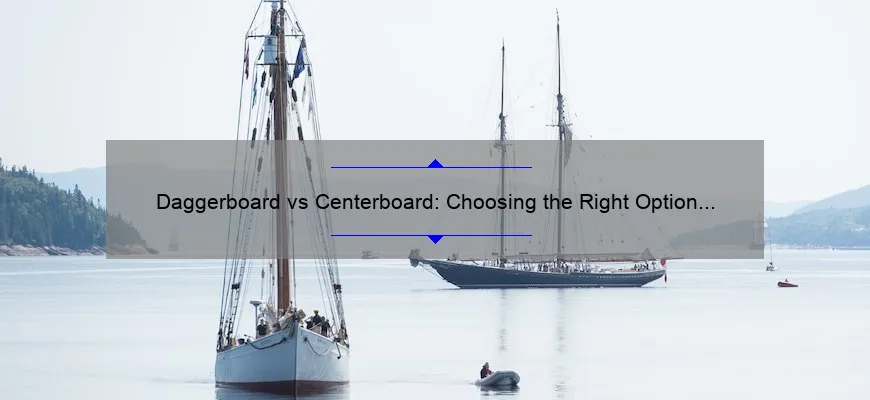
Short answer daggerboard vs centerboard:
A daggerboard is a retractable keel that can be raised or lowered vertically, providing stability and reducing sideways drift. On the other hand, a centerboard is also a retractable keel but pivots horizontally instead of vertically. While both serve similar purposes, their designs and mechanisms differ in terms of usage and effectiveness depending on the type and size of vessels they are used for.
Comparing Daggerboard vs Centerboard: What You Need to Know
Introduction:
When it comes to sailing, understanding the different types of boards used in sailboats is essential. Two commonly used boards are the daggerboard and centerboard . While both serve a similar purpose of providing stability and preventing lateral movement, there are a few key differences between these two options. So, let’s dive deeper into comparing daggerboards versus centerboards to shed some light on what you need to know.
1. Definition:
To start with, let’s define each board type. A daggerboard is a retractable keel that can be raised or lowered vertically through a slot in the hull of a sailboat. On the other hand, a centerboard is also an adjustable keel-like appendage but pivots around a single point when lifted out of the water .
2. Functionality:
The primary function of both boards is to counteract the sideways forces generated by wind acting on the sails and maintain stability in the water. However, they achieve this goal using slightly different mechanisms.
With a daggerboard, sailors have more control over adjusting its depth as it can be raised or lowered at will. This allows them to fine-tune their boat’s performance according to wind conditions and desired speed.
On the contrary, centerboards offer less adjustability and usually have set positions determined by design. Nevertheless, they still provide adequate lift and resistance against sideways drift while sailing close-hauled or upwind.
3. Performance:
When it comes to performance comparison between these two options, both have their pros and cons depending on factors such as boat size, sail plan, and intended use.
Daggerboards generally provide superior upwind performance due to their ability to be adjusted for various wind angles precisely. They allow sailors to optimize for maximum lift while minimizing drag in challenging conditions like gusty winds.
Centerboards excel in downwind sailing situations where maintaining optimal balance becomes critical. Their fixed position contributes additional stability during fast runs or when navigating waves, making them a favorable choice for racing scenarios or larger sailboats .
4. Construction and Maintenance:
Another aspect to consider is the construction and maintenance of these boards. Daggerboards are often made from materials such as fiberglass, carbon fiber, or wood laminates, requiring periodic inspection for wear and tear. However, they can be easily removed during maintenance or storage.
Centerboards are commonly built using similar materials but differ in their pivot point mechanism. The pivot offers simplicity and fewer moving parts that could potentially fail over time. Nonetheless, periodic inspections are still recommended to ensure the board remains secure within its casing.
5. Adaptability:
For sailors who enjoy exploring various water conditions, adaptability becomes a significant factor when comparing daggerboards and centerboards.
Daggerboards prove to be more versatile in this regard as their adjustability allows for experimentation with different sailing techniques on changing water types. This attribute makes them particularly suitable for sailors looking to venture into both shallow waters and deeper offshore locations while keeping their vessel stable.
Centerboards, although limited in terms of adjustability, offer reliability and ease of use across a wide range of sailing environments. They work exceptionally well for recreational sailors who primarily navigate deepwater areas without the need for frequent adjustments.
Conclusion:
In conclusion, understanding the differences between daggerboards and centerboards is crucial when considering which option best suits your sailing needs. While daggerboards provide greater performance optimization capabilities across wind angles and various conditions, centerboards offer stability and reliability in both recreational cruising and racing scenarios.
Ultimately, it’s essential to carefully evaluate your requirements based on boat type, desired performance characteristics under specific weather conditions, as well as personal preferences before making a decision between these two distinct but equally valuable options: the versatile daggerboard or steadfast centerboard.
Understanding the Difference: A Step-by-Step Guide to Daggerboards and Centerboards
If you’re passionate about sailing or have recently taken up the sport, you might have come across the terms “daggerboard” and “centerboard.” While these two components are integral to a sailboat ‘s performance, their roles and characteristics can sometimes be confusing. In this comprehensive guide, we will take you step-by-step through everything you need to know about daggerboards and centerboards – shedding light on their differences and helping you make informed decisions for your own sailing adventures.
First things first, let’s define both daggerboards and centerboards. Both of these structures are essentially appendages that extend from the hull beneath a sailboat. They serve a shared purpose: providing lateral resistance against the force of the wind, preventing the boat from being blown sideways while allowing it to move forward effectively. However, there are distinct variations in design, functionality, and usage between them.
Let’s start with daggerboards. As their name suggests, these boards resemble daggers due to their shape – long and narrow blades that slide vertically into slots in a boat’s hull. Typically located amidships or towards the stern of a vessel, daggerboards are commonly used in high-performance racing yachts or catamarans . Their primary function is to counteract the sideways force generated by wind acting on sails positioned away from where they attach to the mast – an effect known as “lee helm.” By adjusting or deploying multiple daggerboards asymmetrically, sailors can optimize their boats’ performance by minimizing drag while maximizing lift.
On the other hand, centerboards serve a similar purpose but differ significantly in design and usage compared to daggerboards. Unlike fixed daggerboads that slide vertically into slots within a hull structure permanently mounted on a boat’s keel or inside its hull at centreline position (often hollow), centerboard systems rely on pivoting mechanics and vertical movement.
To put it simply, centerboards pivot around a fulcrum or a pin attached to the hull, allowing them to be raised or lowered as needed. They are often found in sailboats designed for recreational purposes – such as small dinghies, daysailers, or even some keelboats. Centerboards can be retracted fully into the hull for shallow-water sailing and ease of launching or landing – an especially useful feature when dealing with beach landings. When lowered into position, they provide similar lateral resistance as daggerboards but typically offer less efficiency due to their simplified shape and lesser surface area.
Now that you understand the basic concepts behind daggerboards and centerboards, let’s explore their advantages and considerations. Daggerboards excel in providing substantial lateral resistance and increased lift capability due to their more refined shape and positioning options. The ability to adjust multiple daggerboards asymmetrically can lead to improved performance under varying wind conditions, making these boards indispensable for competitive sailors seeking optimal speed.
In contrast, centerboards are known for their versatility and convenience. Their pivoting mechanism enables them to be easily raised or lowered while on the water – a valuable asset when navigating shallow waters without risking damage or grounding the boat. Moreover, many small sailboats with centerboard designs also benefit from enhanced stability since the board’s weight aids in counteracting heeling forces acting on the sails.
When choosing between a daggerboard setup or a boat equipped with a centerboard system, several factors come into play. Firstly, consider your sailing intentions: are you primarily interested in casual cruising, racing competitively with precise maneuvering requirements or something in-between? Secondly, assess your local sailing conditions: do you frequently encounter challenging wind patterns or navigate areas with shallow waters ? These aspects will help steer you towards the most suitable option for your needs.
Ultimately, whether you opt for a sailboat equipped with a daggerboard system or one featuring a centerboard mechanism depends on various factors, including performance goals, sailing preferences, and intended use. Don’t hesitate to consult with experienced sailors, boat designers, or reputable manufacturers to ensure you make the right choice.
In conclusion, understanding the key differences between daggerboards and centerboards empowers sailors to select the appropriate configuration for their specific needs while navigating diverse sailing environments. Both appendages play crucial roles in enhancing sailboat stability and maneuverability, but their designs and functionalities vary significantly. Take into account your sailing aspirations and local conditions when making a decision – ensuring an enjoyable and successful experience on the water !
FAQ: Decoding the Pros and Cons of Daggerboards vs Centerboards
Title: FAQ: Decoding the Pros and Cons of Daggerboards vs Centerboards for Smooth Sailing
Introduction: Ahoy, fellow boating enthusiasts ! As you venture into the exciting world of sailing, one critical decision awaits you on your quest to harness the wind’s power. Today, we dive deep into deciphering the age-old conundrum—daggerboards or centerboards? Strap on your life vests as we embark on a journey to unravel the pros and cons of these two remarkable appendages that determine our vessel’s stability and maneuverability.
1. Understanding Daggerboards: Daggerboards, like stealthy underwater swords, elegantly slice through waters beneath our hulls. These vertically retractable boards are typically found in high-performance sailboats, optimized for speed and agility. But what makes daggerboards such an enticing choice?
Advantages of Daggerboards: a) Enhanced Speed: When engaged correctly, daggerboards create less drag compared to fixed keels or centerboards while maintaining lateral resistance. This enables your vessel to cut through water with minimal resistance, giving you a serious edge in speed races. b) Improved Upwind Performance: Daggerboards lend invaluable assistance in maximizing upwind sailing angles by resisting leeway—a fantastic asset when navigating against adverse currents or winds . c) Advanced Maneuverability: The ability to raise and lower these boards allows for easy adaptation to different sailing conditions without limiting boat movement possibilities.
Disadvantages of Daggerboards: a) Costly Investment: Opting for daggerboard-equipped vessels may lead to a higher upfront investment due to their intricate design and construction. b) Maintenance Complexities: Attending to daggerboard mechanisms demands regular inspection and occasional repairs; proper care is essential for long-term performance . c) Limited Draft Range: Some sailors argue that daggerboards hinder access to shallow waters due to their deeper draft range compared to centerboards.
2. Unveiling Centerboards’ Secrets: Now, let’s dive into the undeniable allure of centerboards—a versatile alternative that has carved its place in the sailing community. Positioned within a sailboat’s hull, these retractable appendages offer unique advantages worth considering.
Advantages of Centerboards: a) Versatility: The retractable nature of centerboards allows for easy maneuvering in shallow waters or when navigating close to shore. No more worrying about running aground! b) Cost-efficiency: Boats with centerboards tend to be more affordable compared to their daggerboard-equipped counterparts, making them an attractive choice for budget-conscious sailors . c) Simplicity in Maintenance: With fewer moving parts and mechanisms, the maintenance requirements for centerboards are often less complex and demanding.
Disadvantages of Centerboards: a) Compromised Performance: Sailing aficionados argue that centerboards might sacrifice performance compared to daggerboards due to increased drag and reduced lateral resistance. b) Limited Upwind Performance: When faced with strong winds or currents pushing against your vessel, centerboards may struggle to maintain course stability effectively.
Conclusion: Now that we’ve embarked on this quest through the pros and cons of daggerboards versus centerboards, it’s time for you to weigh your options carefully. Consider factors like your desired sailing style, local water conditions, budget constraints, and long-term maintenance commitments. Remember, whether you opt for the sleek agility of daggerboards or the versatile adaptability of centerboards—safe voyages and thrilling adventures await as you navigate through uncharted waters!
Exploring the Advantages of Daggerboards and Centerboards in Sailing
Are you an avid sailor or someone looking to dip their toes into the exhilarating world of sailing ? If so, understanding the advantages that daggerboards and centerboards provide can significantly enhance your sailing experience. These essential components are not only cleverly designed but also play a paramount role in improving a sailboat’s performance on the water . In this blog post, we will delve into the details of these devices, uncovering their remarkable benefits.
Firstly, let’s start by demystifying what daggerboards and centerboards actually are. Both of these apparatuses serve the same purpose – they stabilize a sailboat by providing lateral resistance, preventing it from drifting sideways due to wind pressure. However, they accomplish this task through different mechanisms.
Daggerboards are retractable foils that typically slide vertically from within the hull. These appendages are often found on high-performance racing boats as they offer numerous advantages. One notable advantage is their ability to maximize speed by minimizing hydrodynamic drag. When deployed correctly, daggerboards reduce sideways drift and lift the boat out of the water slightly, reducing wetted surface area and frictional resistance – resulting in enhanced speed through the water .
Additionally, daggerboards have another trick up their sleeve – adjustable angle-of-attack. Sailors can fine-tune these boards to suit different wind conditions, allowing for optimal performance based on variable factors such as wind strength or direction. This adaptability ensures that you are always at an advantage when facing changing weather conditions during races or leisurely sails.
On the other side of things, centerboards – unlike daggerboards – pivot horizontally from within the hull towards the boat’s midline. Although they lack some of the advantages provided by daggerboards regarding drag reduction and adjustment capabilities, centerboards excel in versatility and accessibility.
One significant advantage that centerboards offer is their ability to navigate shallow waters easily. You’ll find these boats cruising close to shorelines and in areas where draft limitations exist, such as lakes, rivers, or even windy coastal havens with numerous sandbanks. The retractable nature of centerboards allows sailors to raise them fully when entering shallow waters, minimizing the risk of grounding the boat while still maintaining excellent balance and control .
Furthermore, the positioning of a centerboard closer to the boat’s center of mass assists in preventing excessive heeling (tilting) during sailing . For those new to sailing or those who prefer a more stable ride, this can provide a greater sense of safety and security on the water.
In conclusion, both daggerboards and centerboards bring distinct advantages to sailboat enthusiasts. Daggerboards offer improved hydrodynamics for speed enthusiasts while providing adjustability for varying wind conditions – perfect for competitive racing or achieving top-notch performance. On the other hand, centerboards excel in versatility by allowing sailors access to shallow waters without sacrificing stability.
Whether you’re aiming for podium finishes in a regatta or simply seeking an invigorating recreational experience on the water, having a good understanding of these vital components will undoubtedly elevate your sailing adventures . So next time you hoist those sails and feel the saltwater spray on your face, appreciate how these cleverly designed daggerboards and centerboards optimize your vessel’s performance, granting you unparalleled control and enjoyment throughout every voyage.
How to Choose Between a Daggerboard and a Centerboard for Your Sailboat
Choosing the right type of board for your sailboat is a crucial decision that can greatly impact your sailing experience. Two popular options are the daggerboard and the centerboard , each with its own unique advantages and considerations. In this blog post, we will delve into the intricacies of these two board types to help you make an informed choice for your vessel.
Let’s start by understanding what a daggerboard and a centerboard actually are. Both are vertical boards positioned in the keel to provide stability and prevent sideways drift. The primary difference lies in their configuration and functionality.
1. Daggerboards: Imagine a dagger slicing through water with precision – that’s precisely how daggerboards operate! These long, narrow boards are fully retractable, typically made from high-strength materials like fiberglass or carbon fiber. They offer excellent hydrodynamic efficiency, leading to enhanced upwind performance and minimizing leeway (sideways drift) during sailing .
Why opt for a daggerboard? Well, if you’re passionate about racing or want to explore faster sailing speeds, daggerboards should top your list. With their ability to be raised or lowered at will, they allow countless adjustment possibilities while on the water – from optimizing your boat ‘s balance based on wind conditions to maneuvering through shallow waters without worrying about grounding.
However, there are some drawbacks worth considering before committing to a daggerboard. Due to their intricate design and construction, they tend to be more expensive than centerboards. Additionally, retracting them may require physical effort or even hydraulic assistance on larger vessels.
2. Centerboards: Centerboards share similar functionality as daggerboards but differ in construction and operation. Unlike daggerboards that slide vertically within casing built into the hull of the sailboat, centerboards pivot horizontally from its midpoint inside the hull itself.
So why go for a centerboard instead? Primarily known for their versatility and adaptability across various boat types – dinghies, daysailers, or cruisers – centerboards provide easy access to shallow waters. As they pivot up into the hull, the sailboat’s draft decreases, allowing you to explore areas that would otherwise remain inaccessible.
If budget constraints are a concern, opting for a centerboard might be more economical compared to a daggerboard . They are generally simpler in design and easier to maintain due to their horizontal movement mechanism.
Nevertheless, keep in mind that centerboards may compromise your sailing performance slightly. Although they perform reasonably well upwind and allow sailing closer to the wind than boats without any keel at all (known as leeboards), they are not as efficient as daggerboards when it comes to performance-oriented sailing.
In conclusion, choosing between a daggerboard and a centerboard ultimately depends on your specific requirements and intended use of the sailboat. If you crave exhilarating speeds, impeccable upwind capabilities, and have room in your budget for a high-performance board, go for a daggerboard without hesitation. On the other hand, if versatility, cost-effectiveness, and shallow-water exploration take precedence over pure speed obsession, opt for a centerboard.
Remember that regardless of which board you choose; practice and experience will play crucial roles in mastering its deployment and optimizing its effect on your sailing adventures . Happy cruising!
Going Beyond Basics: Mastering the Use of Daggerboards vs Centerboards
Title: Going Beyond Basics: Mastering the Art of Daggerboards vs Centerboards
Introduction: When it comes to sailing, achieving optimum performance requires more than just a basic understanding of the equipment. To truly excel in this beautiful sport, sailors need to delve deeper into the intricacies of their vessel’s components. One such critical component is the choice between daggerboards and centerboards. In this blog post, we will explore these options in detail, shedding light on their characteristics, benefits, and how mastering their use can take your sailing skills to new heights.
The Difference Between Daggerboards and Centerboards: Before we dive into their nuances, let’s begin by understanding the fundamental difference between daggerboards and centerboards. Both are retractable fins intended to prevent leeway (sideways drift) when sailing against the wind . The primary variation lies in their location on the hull. Daggerboards are inserted vertically through slots located towards the middle of each hull side on catamarans or near the keel area on monohulls. Conversely, centerboards are mounted on pivots below the hull at its central point.
Daggerboard Dominance: 1. Performance Advantages: Daggerboards provide sailors with remarkable advantages when it comes to sailboat performance. Their vertical positioning allows for reduced drag and enhanced lift characteristics compared to centerboards. 2. Upwind Sailing Power: Due to their dynamic design, daggerboards enable better upwind sailing as they can be further extended downwards into deeper water when necessary – increasing resistance against being pushed sideways by wind pressure. 3. Higher Speed Potential: By reducing leeway during upwind maneuvers, daggerboard-equipped boats experience less resistance and consequently achieve higher speeds. 4. Enhanced Steering Control: Another noteworthy benefit of daggerboard usage is improved steering control under demanding conditions like strong winds or rough seas.
Centerboard Superiority: 1. Versatility across Depths: Compared to daggerboards that require specific water depths, centerboards allow sailors to venture into shallower waters. The ability to raise the centerboard partially or completely reduces grounding risks and grants access to areas otherwise inaccessible. 2. Simplified Maneuverability: With a fixed pivot point across all wind conditions, centerboards are more straightforward and hassle-free to operate. Their stability provides consistent performance, making sailing a breeze for beginners and less experienced crews. 3. Safety in Grounding Situations: In the unfortunate event of running aground, a centerboard is designed to kick up easily upon contact with solid objects, minimizing potential damage to both the board and the hull.
Mastering Daggerboards vs Centerboards: 1. Understanding Conditions: To make an informed choice between daggerboards and centerboards, it’s crucial to assess the predominant sailing conditions you encounter. For open-water excursions where speed reigns supreme, daggerboards are often favored. Conversely, if your voyages take you through varied depths or potentially shallow areas, a centerboard may be more advantageous. 2. Gradual Familiarization & Practice: Like any skill in sailing, mastering the use of daggerboards or centerboards necessitates practice and experimentation. Sailors who wish to truly harness these components should gradually familiarize themselves with how they influence the boat’s performance by adjusting their depth according to wind strength and direction. 3. Seek Expert Guidance: Advanced sailors seeking technical expertise can benefit from reaching out to experienced professionals or participating in sailing clinics focused on advanced techniques involving daggerboard or centerboard utilization.
Conclusion: In summary, going beyond the basics of sailing involves mastering intricate aspects such as choosing between daggerboards and centerboards. Each has unique advantages catering to different sailing scenarios and personal preferences. By honing your understanding of these components’ functionality along with practice at utilizing them optimally under varying conditions enable sailors to unlock remarkable improvements in speed, maneuverability, and control – elevating their overall proficiency in the art of sailing.
Recent Posts

- Sailboat Gear and Equipment
- Sailboat Lifestyle
- Sailboat Maintenance
- Sailboat Racing
- Sailboat Tips and Tricks
- Sailboat Types
- Sailing Adventures
- Sailing Destinations
- Sailing Safety
- Sailing Techniques
Daggerboards
The majority of today's cruising catamarans are equipped with mini keels for reliable and hassle-free operation. There are fewer than a handful of production daggerboard catamarans, which provide the sailor slightly more pointing ability and other advantages as illustrated in previous chapters. Their operation is generally straightforward via either a single uphaul line in case the board is heavier than water, or by an additional downhaul to keep the foil lowered, in case it is more buoyant.
Needless to say, when trying to point as high as possible, the leeward board should be fully deployed. The finer the hulls of the catamaran and deeper the foils are, the more they will contribute to getting the multihull to windward. In very rough conditions, when the boat will be thrown around by wind and waves, it is a good idea to divide the loads between both boards and only let them halfway down.
Marking the daggerboards at deck level will help indicate a "control" depth and assist in judging when they will be extending deeper than the rudders and thus aid in protecing them in case of a collision.
For a more detailed description of daggerboards and their use, please refer to the "Appendages" chapter.
Continue reading here: Tacking
Was this article helpful?
Recommended Programs

Myboatplans 518 Boat Plans
Related Posts
- Reefing - Catamarans Guide
- Appendages - Catamarans Guide
- Explain The Hydrodynamics Of A Daggerboard
- Catamaran Design Guide - Catamarans Guide
- Rudders - Catamarans Guide
- Jaguar - Catamarans Guide

- About Aeroyacht
- Aeroyacht Design
- Aeroyacht TV
- Mission Statement & Privacy Policy
- Aeroyacht Racing
- Favorite Links
- Customer Testimonials
- Office Location
- BUY A MULTIHULL
- Specifications
- Photo Gallery
- Try Before You Buy
- Yacht Ownership and Demo Sails
- BUY A POWER CATAMARAN
- Yacht Business Ownership FAQ
- MULTIHULLS FOR SALE
- Aeroyacht Superyacht Catamarans
- Global Multihull Search
- Buy A Multihull
- Sell a Multihull
- Multihull News
- Publications & Articles
- Commissioning & Delivery Services
Multihull Keels and Daggerboards

Fountaine Pajot BELIZE 43 resting on her keels, showing good bridge deck height
Uncovering the compromises of both underwater appendages and analyzing their disadvantages and merits.
Man has learned much from nature, and sailboats and their underwater appendages are one of the areas that we have applied what works and what doesn’t. As we all know, boats – as most things in life- are compromises and often we are prepared to make concessions in one area in order to gain an advantage in another. Not only should this brief discussion illustrate the basic virtues and drawbacks of daggerboards and mini keels on multihulls, but also point out their active and passive safety aspects.
Most multihulls in todays marketplace come in two varieties. By far the vast majority of the production cruising catamarans (about 90%) are keelboats and have low aspect ratio, unballasted keels. These well known French, Australian or S.African boat manufacturers market their boats for private ownership and the charter industry and make a great product. Without sounding too general, these boats have very spacious interiors and are perfectly adaptable for live aboard families or the charter trade. This multi million dollar charter industry, has an obvious influence on the requirements and design of their charter fleet, which further has a trickle down effect to other builders who also market their cats for private ownership. Design parameters for these charter cats are often centered around 2 week multiple family vacations in the steady Trade Winds and day sails between closely spaced islands of the Caribbean. The features of these keel catamarans obviously put less demand on pure sailing performance or extreme upwind sailing characteristics, but rather try to please by offering solid construction, live aboard comfort and simple and reliable handling characteristics.
The other type of multihull is the catamaran with articulating daggerboards or centerboards. Centerboard and daggerboard multihulls both share the same basic concept, except their deployment and storage relies on different principles. The daggerboard lives in a scabbard, or daggerboard trunk. It moves up and down, vs. a pivoting centerboard, which is raised and lowered around a massive pin. High aspect ratio daggerboards are by far the most efficient foils. They have none of the problems associated with centerboards, which when fully lowered are only braced by a small area on top. When going upwind in a hurry, loads on the trunk act as a giant lever, which constantly work to spread the trunk apart. This is the reason why it is recommended to operate foils as pairs in heavier conditions to divide the loads. Also the large area of the remaining centerboard slot creates a lot of unwanted turbulence making them unpopular for performance minded sailors. Lastly declining popularity of the centerboarders can also be lead back to the often large intrusion on the interior space the trunks create. Although the Gemini catamaran is a good example of a very popular and well thought out production catamaran, there are few other mass produced centerboarders around. It should be noted that one great advantage centerboards have vs. any other underbody configuration is that they theoretically retract when colliding with an object. In spite of this, most offshore or performance orientated sailors clearly favor daggerboards or low aspect ration keels.

Illustration A
Daggerboard catamarans have several advantages over their keel counterparts, some of which are well known and others that are more subtle and sometimes only recognized by people who have used them. Active safety aspects are advantages created by speed and the ability to retract underwater appendages.
I am a firm believer of “faster” rather than “slower” on ocean going performance multihulls. Many people might say, going fast is only for racers. But lets think about this. The ability to reduce exposure time through speed is invaluable for cruisers. If say on a transatlantic passage you can shave off 5 days you have already increased your safety factor, in some cases, by 25%. Not being a “sitting duck” is a nice thing indeed. By being able to have the choice, bad weather can be avoided, which can sometimes lead to a negative spiral of incidences. In general, especially on long passages, a daggerboard cat will have the edge on speed over her keel counterpart.
Lets face it, we are all in it for the fun of sailing as famed designer Francis L. Herrshoff said: “The fun of sailing is directly proportional to the speed of sailing”. Maybe this is the reason he designed Amaryllis, his revolutionary catamaran, which was later banned from racing. Generally speaking daggerboard catamarans will always be slightly faster than their keel equivalents. The speed advantage of most daggerboard catamarans vs. keel catamarans though is often exaggerated. On a typical day sail a well trimmed and tuned keel cat will only be slightly slower than a daggerboard cat.
Multihulls lack the feeling of being in the “groove”, which monohull sailors enjoy. Effortless high average speeds, acceleration and sustained high velocity surfs is something fast multihulls compensate with. It should be noted that anything (even a barn door) surfs in the right conditions. Even keel catamarans can surf at speeds up to 30 knots down large seas.
Upwind Advantages: Depending on sea state going upwind, daggerboard catamarans vs. their keel relatives will point up to 5 degrees higher and also experience 2-5 degrees less leeway, which isn’t much one would think. But in an uncomfortable 100 mile beat this ads up to being more than 17 miles closer to your destination! (Illustration B).

Illustration B
sin A=a/c (sin A) c =a (0.1736) * 100 = a a = 17.36 miles
Lets take a 45’ catamaran: the lift (to windward) generated by a daggerboard is almost twice that of a low aspect ratio keel and the drag with the board all the way down would be almost 20% less. The most recent generation cats with large beams and stately bridge deck houses benefit especially from high lift foils, since the windage of their projected area can ad up quickly. The same cats with keels usually suffer from excessive leeway and sideslip. Keel cat’s however, especially in a calm sea state, lessen this disadvantage as boat speed and flow over their keels increases.
Reaching and Running Deep: When running deep in fresh conditions the fixed could act as a brake, that one cannot disengage. Since they cannot be retracted, their volume and resistance slows the boat’s progress and in combination with the forward pressure of the sails forces the bows down. This is especially the case with catamarans that have long bridgedecks, heavy extremities and low volume- fine bows. The bigger the friction in the water, the bigger the pressure on the mast and the more the boat is burdened. Another neat trick is lifting the daggerboards, one can actually increase apparent wind by pointing up and induce leeway, crabbing faster to ones destination.
Tacking and Helm Feedback: Cruising catamarans are often mistaken to tack slowly and behave sluggishly to movements of the helm. This is certainly true for some heavy keel catamarans and much less so for ones equipped with boards. In complex seas, some of the heavier keel cat’s only option for a safe tack is back winding the jib. Monohulls with only one fin will always tack quicker than multihulls, just as foil equipped catamarans will be more responsive than keel multihulls. Modern hydraulic steering systems are easy to build and with most forward helm stations behind the main coachroof, pose sometimes the only alternative for the builder. Mechanical steering and daggerboards will give the ultimate feedback and fun at the helm…if one is driving at all, since usually the autopilot is engaged for longer legs.

Inclined foils on the Aeroyacht H42 performance catamaran built by Edel
Another advantage of daggerboards is the better maneuverability under one engine. If you loose one engine and retract the board on the hull which has no engine power, but leave the powered hull’s foil down, the boat will turn easier. Because of the retracted foil on the un-powered side there will be much less drag induced turning moment, the boat will be more balanced and the other sides deployed board will provide sufficient bite for “survival” steerage. Especially in high crosswind situations a catamaran with both boards down is much easier to maneuver than one with shallower keels. Usually harbor maneuvers under power are low speed operations, and this is where the high lift capacity of twin boards excel yet again and facilitate handling and precision steerage. Daggerboard cats also can motor a bit faster, since by retracting the foils they have less resistance.

Keel and daggerboard cats usually have less draft than keel monohulls, opening access to shallow anchorages. An advantage daggerboards have, are their gauging characteristics when entering shallow harbors or unknown territory. By lowering them, one actually creates a “safety depth”. When they touch bottom one still has the possibility of raising them, performing a U-turn and getting into deeper water. With fixed- non retractable keels, especially with a monohull, groundings or unplanned bottom encounters could end tragic. At least a monhull can attempt in heeling the boat to reduce draft and re float. This obviously is not an option on a keel cat. If you get stuck in the mud you are dedicated to await the next high tide to get you off. Crashing into a coral reef could be a different story altogether and only a haul out can asses and repair damage. Depending on their design, boards could be rotated or flipped, and even repaired underway. In general daggerboard cats also have less draft than keel multihulls allowing access to even more harbors and anchorages. They can be beached high up for repairs or inspections, increasing the window of exposure time between tides. I know, I once performed a 5 hour long emergency repair on our 43’ catamaran this way, saving 1000’s in yard bills and days of headaches.
It should be notes that keel catamarans however, can be beached just as easy as daggerboard cats. They can be left sitting, high and dry, completely safe on their keels, without having to worry about damaging the hulls or getting debris or sea life stuck into the vulnerable daggerboard trunks.
Bruno Nicoletti is an old friend and one of the most low key-expert sailors I know. He has logged more than 130,000 miles (geriatric miles as he calls them) on his 44’ daggerboard catamaran.. At a recent meeting with him in France we talked about his experiences of his record, double handed – one stop- Southern Ocean circumnavigation at age 63. The French Press compares Bruno to sailing legend Vito Dumas and has published his accounts in an article called: “The Impossible Route”. He explained, that in the Southern Ocean, in the most convoluted conditions he would simply raise both boards, lock the helm to windward and lay a-hull with no sails. “Brumas Patagonia” would safely slide down the steep faces of waves and minimally drift to leeward at about 1 mile per hour while he was either resting or reading. The water spoil of his side wards drift would help keep the edge off cresting waves and often prevent them from breaking (Illustration D) While it was blowing 70 knots and higher he felt very safe and in fact the world around him turned peaceful and quiet. His confidence in this system is impressive: I am currently helping him with sea trials on his new 47 footer for a yet another go at a High Latitude – geriatric- circumnavigation. This time he is planning to take his 78 year old brother and do it non stop !

Illustration D
It is not only in the Southern Ocean that one encounters steep, breaking waves. Major capes or the Gulf Stream are notorious for rough conditions where the ability to navigate safely becomes imperative. In these environments any proven and strongly built daggerboard cat would have a slight advantage by lifting her boards, although a well designed keel catamaran could get through unscathed. In extreme weather, and I am talking beyond Force 10, it is very important to enable a catamaran to side-slip rather than encouraging the possibility to trip, and maybe flip. A catamarans behavior in towering side waves is decisive and the possibility to lift underwater appendages is essential, especially if one has lost the ability to steer. The disadvantage of a keel catamaran in huge beam seas is more psychological than real, as these types of vessels typically also slip sideways. In survival conditions or emergencies, the use of parachute anchors, which force the boat into a certain attitude is often thought to be the only answer for most boats. In my mind this tactic is questionable since it puts enormous strains on the boat, is accident prone and renders one helpless when the odd rogue wave from a different direction smacks into the boat. It is better to manage survival conditions, by controlling and slowing the vessel with the use of drogues.
We have learned a great deal from aerospace industry and the trickle down effect to monohull keels. Multihull designers and builders greatly profit from the advanced research, that has been done in the field of NACA sections (National Advisory Committee for Aeronautics) and foil performance. Keels and daggerboards come in a variety of aspect ratios but most are based on low speed foils, which drag/lift characteristics have been optimized. To increase lift even further, some performance catamarans even utilize asymmetrical shaped daggerboards, shaped flat on the outside (leeward) and cambered on the (windward) inside. As they can only be used one at a time asymmetrical boards are somewhat limited in their adaptation for cruisers. (Illustration E)

Illustration E
Since multihulls do not heel, their underwater appendages are more effective in retaining positive flow than their monohull relatives.(this is also the reason why autopilots burn out less often and can be used in heavier conditions on catamarans) As the monohull heels, not only is the upper part partly blanketed by the underbody of the vessel but also flow is lost as the water slips past the angled keel to leeward. (Illustration F) This was especially prevalent on the early IOR monos, which had extremely beamy and shallow bilges and high prismatic coefficient center sections. To compensate for this loss of heel induced flow, monhulls need deep draft keels to make good progress to windward. The keel or daggerboard catamaran on the other hand can more efficiently create lift for the same keel plan view area, not only because it has two vs. one keel, but also through its minimal heel is able to keep its underwater appendages perpendicular in the water.

Illustration F
Usually catamaran daggerboards have a higher aspect ratio and are deeper than the equivalent length monohull, since they have the ability to retract them and therefore have no draft considerations. It is therefore not surprising to see that in wind speeds starting at around 10 knots a well designed and sailed daggerboard cat, will often outpoint and outpace a performance monohull. Even well sailed keel catamarans can often arrive earlier at an upwind destination compared to heavy monohulls. The couple of degrees they sacrifice in their ability to point to windward is often made up by their higher speed and VMG (Velocity Made Good). This performance difference increases proportionally to the wind speed and is very noticeable in F.4 conditions and beyond.
A well known fact and possibly the single biggest psychological deterrent of daggerboard cats is the vulnerability of the boards and trunk in collisions. The true Achilles heel are actually ill constructed and designed trunks, which cause flooding in an impact. This obviously is not the case with keels, which would deflect a minor obstacle, or in case of hitting a container or whale, simply break off. In the case of sacrificial keels, they would sheer leaving the hull completely intact.
Obviously the most critical area in daggerboard design is the construction of the daggerboard trunk. It is usually heavily reinforced with massive gussets, especially at its aft bottom end and extends from the bilge to the overhead. Typical forces on the trunk easily exceed the pressure of the wind on the sails. Dynamic forces of wave action and the shock loads of slamming into seas or solid objects must make this area one of the strongest and best engineered of the entire vessel. Usually the foils are located just aft of the main- mast bearing crossbeam and are somehow tied into this unit to profit from its stiffness. The more “left over” daggerboard remains in the scabbard in the fully down position, the better it is braced, so it is not surprising to see foils that are 18’ long for a 60’ boat. Builders who take their job seriously go through great lengths to make this key area as strong as possible. In a recent conversation with the manager of a reputable French production yard it was pointed out that the daggerboard trunk is engineered and constructed 7 times stronger than the composite board. In case of a violent impact, the foil, which has weak spots designed into it, will snap and leave the daggerboard trunk unscathed. It is a type of sacrificial impact philosophy or a safety fuse, just as it is used on sacrificial fixed keels. The careful engineering and experience necessary in building reliable daggerboard or keel cats stresses the importance of a production yard, which has consistently built them. This aspect should not be taken lightly if one ventures out into the open sea, even if it is only 20 miles offshore.

Often builders of keel cats ad daggerboards to their designs, with the objective to market increased performance and safety. This usually ends up in a compromise, since the hydrodynamic hull requirements of both types could differ substantially, let alone the experience of proper integration, engineering and construction might be lacking altogether. Building with keels does not require the experience, careful construction and engineering which are necessary with retractable foils.
Keels offer advantages, as they do not need to be operated at all. They do their work silently and its usually one less thing to go wrong. On the other hand people who have never sailed with daggerboards think their operation is complicated. In fact they are as easy to use as outhauls or travelers. In normal conditions with 2 people – one pumping the daggerbaords up haul line directly at the board- the other taking up the slack of the up haul, it literally takes 3 seconds to raise a 15’ daggerboard. Single-handed it is a 10 second affair involving 2-3 wraps of the up haul around a winch and 10 cranks. Most boards are slightly heavier than the water they displace and often only weigh 80 lbs. Dropping takes half a second, by simply opening the up haul sheet stopper and easing the foil down. Loads on the boards increase as the speed and pressure builds, so if one has the choice, these maneuvers are usually performed just before tacking. It is a misconception that the operation of foils will depend on the wind speed. It is rather the boat speed, in regards to sea state – which in turn limits progress – which dictates the proper positioning of the daggerboards.
Nothing is perfect and this analysis would be worthless without mentioning the pro’s and con’s of either underwater appendage. Daggerboards, their surrounding structures and systems are more expensive to build, so builders prefer to stay away from them given the choice. In some catamarans, especially smaller ones or ones that have the trunk in the center of the hull, the interior passage in the hulls can be crammed. Lastly it should be mentioned that incorrectly designed and constructed, daggerboards multihulls can be more of a detriment than virtue and in some cases can be extremely dangerous. If the trunks are not massively reinforced and in case of a violent collision one could flood one hull and cause a capsize. In this case one is better off with a well designed and constructed keel multihull than a mediocre or untested one with daggerboards.
Yet daggerboards give you choices, that keels deny you. It is like the new generation of cars with Tiptronic gearboxes, which offer you an automatic transmission with manual override. By physically selecting the proper gear, torque can be adjusted to suit the conditions. It’s the same with the daggerboard equipped catamaran. The boat can be fine tuned to optimize the level of efficiency of the vessels motion through the water. By being able adjust the foils, superior sailing characteristics result in speed and generally more fun on the water. Active safety aspects of reduced exposure time, better maneuverability and shallow draft provide significant benefits.
For safety reasons, most catamarans builders opt for fixed keels and completely separate the keels from the hulls, a feature which preserves and protects the water tightness of the boat in the event of violent impact. Furthermore, if such a situation arises, it makes them easier to repair or replace. Fixed keels require no manipulation, such as daggerboards and give perfect protection to drive shafts, propellers, rudder blades and hull bottoms in the event of grounding. Lastly the absence of a centreboard case means saving of space in the interior of the vessel and usually results in a larger living space.
Back to the birds. We all know the giant Albatross as an extreme example of a sorer that can glide for days in varying conditions, without having to move its wings. This Southern Ocean beast, who calls his home the most inhospitable area on our planet, is better adapted to handle extreme circumstances than any other flying animal. The Albatrosses’ wings are sophisticated in shape, but basically are articulating high aspect ratio foils very similar to daggerboards. Similar to the Falcons “high speed” wings, the Abatross can modify its wings aspect ratio to adjust to the breeze. The designers of the Polynesian multihulls, legendary Viking long ships and American Cargo Schooners understood this too. By adding movable leeway devices, center- or daggerboards, they made their boats more seaworthy and even sailors in the past preferred them over fixed keels.
Today we continue to strive to find the perfect compromise in our vessels to satisfy our most important requirements. We should be extremely thankful to the 1000’s of keel multihulls that have revolutionized the charter industry and many good boats have evolved from this trend. Reputable dagger board catamarans and well designed keel multihulls will continue to be the choice of future generations of serious offshore voyagers. Both offer their advantages and disadvantages and it is important to understand both in order to make the proper choice.
Gregor Tarjan, a trained naval architect and longtime multihull enthusiast is writer of numerous articles for Multihulls Magazine and various other trade publications. He has been involved in Dennis Conner’s “Stars and Sripes” 1984 Americas Cup Campaign, is the founder of Aeroyacht.He is also the co-editor and contributing author of the “Sailors Multihull Guide”, the book by Kevin Jeffrey.
Social Share
Catamaran news.

NEEL 43 “PERFORMANCE” Version – a special Limited Edition Trimaran

NEEL 52 Trimaran – Immersive 360 Experience

Newest photos of the McConaghy 75 catamaran

Free Multihull Charter before you Purchase

NEEL Trimarans Owners Community
- Catamaran Steering Positions
- Catamarans vs. Monohulls
- Catamaran Learning Center
- Catamaran Speed
- Catamaran Efficiency
- Catamaran Stability
- Catamaran Safety
- Catamaran Shallow Draft
- Catamaran No Heel Sailing
- Catamarans and Seasickness
- Catamaran Space
- Catamaran Boat Handling
- Catamaran Advantages over Monohulls
- Wave-Piercing Bows
- Catamaran Sailing Schools
- Catamaran Insurance
- Catamaran Charter Business and Tax Savings
- Ask the Owner
- 5 Valuable Tips
- Survey Checklist
- Sea Trial Checklist
- MULTIHULLS & CATAMARANS App for Iphone
- Catamaran Surveys
- Multihull Services
- Catamaran Build Consultation
- Financing Services
- Catamaran Repair & Service Facilities
- Catamaran Demo Rides & Shows
- Catamarans for China
- Yacht Design
- Interior Styling & Yacht Art
- Photography

Nautitech 46 Price Drop
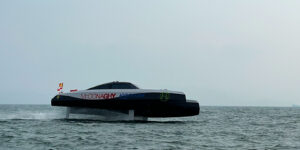
McConaghy Chase ZERO Hydrogen Powered Yacht

McConaghy Multihulls Nominated for Design Award – McConaghy 75 and MC83 Power
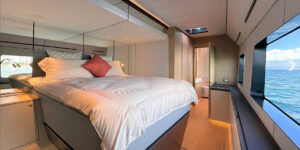
The Stunning Interior Design of the McConaghy Multihull Range

Nautitech Spareparts – Order Simple and Quick
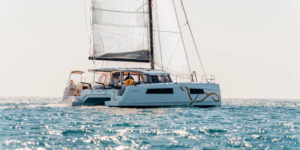
For Immediate Delivery – Nautitech 44 Owner Version
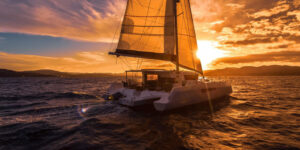
Yannick Bestaven’s NEEL 47 Trimaran

Conser 47/50′ FOR SALE

Planet Sail tests a McConaghy Multihull
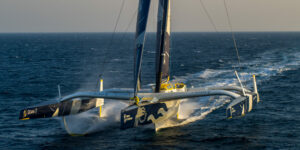
Charles Caudrelier wins Arkea Ultim Challenge
Helpful tips from aeroyacht.
AEROYACHT PUBLICATIONS
Catamaran books by gregor tarjan.

JOIN AEROYACHT’S NEWSLETTER
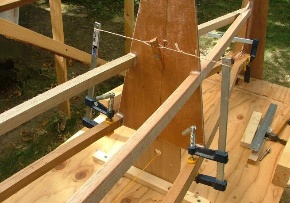
Making a Dagger Board
Although this description is specific for the W17, the concept can be used for almost any dagger or centerboard.
For the W17 dagger board length as designed, first select 3–4 pieces about 1300 mm long. (If you wish to make a slightly longer dagger board, you might need 1.40 m—see plans). Here I used 100 × 25 mm nominal mahogany, which comes pre-planed at 90 × 19 mm thick, so you still need 3 pieces plus a small strip to give you 285 total wood width (290 with glass). Keep in mind, that you are aiming at a final weight of board, with all glass and CF reinforcement, that will just float. [Being much lighter can mean a shock cord strap will be needed to keep it from floating up.]

Although quarter-sawn timber is preferable when available, narrow slab-sawn planks can be bonded as per this sketch to keep potential deformation to a minimum. Lay the boards on 2‑3 long clamps and mark out the outline, so that you'll know how to align the pieces correctly when bonding. Check for twist or warp.
If you do not have enough 300 mm (12") clamps to tie the boards together, it's easy to make them with a strong back, blocks and wedges—see central clamp on photo below. Place a strip of wax paper over this strong back to keep it from bonding to the board.
Spread on a thin film of thickened epoxy with a notched spreader, making sure it fills the saw cuts. Then lay the boards in position and before finally tightening the clamps, use a straight edge across the surface and push up any plank that is below level so that finally, they are all flush with each other.

Only tighten enough to have a small bead of glue squeeze out of the joint. Tap wedges gently also if you're using homemade clamps.

Once almost cured, scrape off the excess resin and leave to harden overnight. Meanwhile, you can plan the shaping. Working from the section of the finished board (as shown for the W17 on Plan 08), draw parallel lines equal side of center, to represent the thickness of the wood core you have. In my case, it was 19, so in order to reach the final thickness of 27, I need a total of 4 mm to be added each side. Well, two layers of CF and two layers of cloth will not be far off 2 mm, so I need just another 2 mm of fill. By drawing the 2 mm of FG 'skin' in from the outer profile, I can determine exactly where that fill should go and it will look somewhat like this.

So now we know where to add some filler—120 mm wide and 2 mm thick, tapering to zero. So mark this area on both sides of the board. These lines will also give you the place to start tapering the wood core, down to say 1 mm wide or less at the rear edge and to 8 mm at the leading edge. Make sure the board is well marked all around with what will be the centerline of the board. This will keep you from creating twist during the shaping process.

You'll need a female guide template, the shape of which you can get from the plans. Make it two sided. One profile to match the finished exterior but the other to be from 1 to 2 mm less width, to directly match just the wood and filler, before adding the carbon fiber and sheathing cloths. It will look like this — except that it pays to keep both forward ends square and not internally rounded as the top profile shows. This is because the front edge of the board will still be square when this used. Then mix and add filler, using a flexible plastic spreader to get the approximate profile. Using sandable filler material, you can afford to put a little more than you finally need, in order to keep the surface fair as a base for the carbon fiber to come next. Naturally, wait until one side is cured before doing the other. Then grind and sand your board until it looks like the required finished product, except that it will be a total of 3‑4 mm under-width at the thick part and 2 mm under, in way of the bare wood at the rear. (Only pre-round the front nose once the section is about perfect, as the square edge serves as a good guide for the profile template.) When you're satisfied, check it all over again and make sure all the dimensions are correct—and for good measure, sand it again. It's pretty easy to still patch and fix right now, but once the carbon and glass go on, you're far more limited. Then give the whole surface a prime coat of epoxy. Lightly sand again. If by chance, you notice that despite all your precautions, the blade is still slightly out of line with the upper part, do not despair, there is still something you can do to correct it.

Lay the board on a flat surface and put a small spacer under the flat upper part so that the centerline of the actual main blade (foil) is the same distance above the table surface all the way around. If you are using say a 20 mm wood thickness, this distance will then be 10 mm. Clamp the board at the top edge with the spacer firmly in place. Now make a small 'bridge' scraper that will bridge the width of the board but where the ends will touch the table surface. The underside of that scraper should be adjustable from 22 to 24 mm above the table (or just make two). Then fill the top surface with a lightweight epoxy putty and scrap this off at 22 mm above the table top. Once cured, flip the board over and do the same procedure (leveling the blade first—now at 12 mm above the table to its centerline) and fill the other side of the top part - leveling that with the scraper now set at 24 mm parallel to the surface. Once cleaned off, your upper part should now have surfaces that are perfectly aligned with the main blade, but now 24 mm total thick.

Read more Construction Tips & Techniques .
"New articles, comments and references will be added periodically as new questions are answered and other info comes in relative to this subject, so you're invited to revisit and participate." —webmaster
"See the Copyright Information & Legal Disclaimer page for copyright info and use of ANY part of this text or article"

IMAGES
COMMENTS
A daggerboard is a retractable centreboard used by various sailing craft. While other types of centreboard may pivot to retract, a daggerboard slides in a casing. The shape of the daggerboard converts the forward motion into a windward lift, countering the leeward push of the sail. The theoretical centre of lateral resistance is on the trailing ...
A daggerboard trunk is a type of daggerboard that is mounted inside the hull of the boat. This allows the daggerboard to be raised and lowered without having to be removed from the boat. A foil daggerboard is a type of retractable daggerboard that is designed to provide additional lift and stability to the catamaran, allowing it to perform ...
9) When the speed increases, it is worthwhile raising the windward board to optimize drag. Note: a daggerboard which moves is no use. Therefore we raise it! 10) But for safety, it is preferable to raise the leeward appendage: in the case of a strong gust, the risk of the boat 'tripping up' is thus reduced.
In very light winds, the standard practice is to lift the windward daggerboard all the way and only trim the leeward board. When both daggerboards are down, (for simplicity) there is now double the 'underwater sail' area. This would likely imbalance how much power there is from the light winds on the sail above the water, and literally ...
On a sailboat, the difference between a daggerboard and a centerboard is how they are moved into position. A daggerboard is lifted and raised vertically (up and down) through a slot in the hull; a centerboard, on the other hand, pivots or swings into place. That was the short answer.
Your sails, keels, daggerboards and rudders when moving forward into the wind create high pressure of the windward side, and low pressure on the leeward side, and the boat is pulled forward, into the wind. Because the foil directs the boat around the curve of the foil, the boat is lifted forward, and to windward. This is also why airplanes fly.
Not all fixed keels are created equal, and because fixed keels by nature have a lower aspect ratio than a daggerboard, the foil section and planform (side view) selection are critical to minimise the tip loss - or the flow that runs under the keel and reduces the lift which provides windward ability. Obviously a relatively deep keel of moderate ...
Catana 39 Daggerboard. But the other thing is that the daggerboards are more expensive to make because you've got to make the daggerboard case, which is in effect, same as making a keel. Then the daggerboard and then the controls for the daggerboard, so that all adds to cost and complication.
Every single HH Catamaran daggerboard goes into our monster testing jig and we apply the full force of the known working load to fly a hull with two reefs and the two times "dynamic load factor". So, an HH66 board gets tested to a staggering 17,000kg, which is really scary. Even with our new HH50, the boards are tested all the way to 10 tons.
The daggerboard does not have a safety fuse integrated into the line driver since they are vertically lifted. If a daggerboard struck an object it would endure the full impact force and transfer the load to the bearing box which would result in higher levels of damage to the board or even the boat. Daggerboards also require real estate in both ...
This catamaran instructional video teaches you how to Use daggerboards on a catamarancome and learn to sail with us! www.adventuresailing.com.au
The importance of a daggerboard - in catamaran sailing. Demystifying the daggerboard. There is nothing mystical about cats that make them inherently poor performers going to wind. In fact, the opposite is true, cats have inherent qualities that make them better than a keel yacht in windward performance. Not leaning over is one of them.
Short answer daggerboard vs centerboard: A daggerboard is a retractable keel that can be raised or lowered vertically, providing stability and reducing sideways drift. On the other hand, a centerboard is also a retractable keel but pivots horizontally instead of vertically. While both serve similar purposes, their designs and mechanisms differ in terms of usage
In the case of the Seward 46RK, the daggerboard, or lifting keel, is comprised of a solid polyester composite, with a fiberglass skin and a series of stainless rods running the length of the foil to both increase stiffness and carry a 7,500lb cast-lead ballast bulb. An electric motor, operated by a set of buttons at the mast, raises and lowers ...
There are fewer than a handful of production daggerboard catamarans, which provide the sailor slightly more pointing ability and other advantages as illustrated in previous chapters. Their operation is generally straightforward via either a single uphaul line in case the board is heavier than water, or by an additional downhaul to keep the foil ...
Centerboard and daggerboard multihulls both share the same basic concept, except their deployment and storage relies on different principles. The daggerboard lives in a scabbard, or daggerboard trunk. It moves up and down, vs. a pivoting centerboard, which is raised and lowered around a massive pin.
Sections through a daggerboard or foil should be fair and consistent and as an aerofoil, have the maximum thickness about 30% of the way back, with a nose radius of approximately 1/4 the max. board width. In terms of material, I am personally not in favor of plywood as they ultimately do breakdown and also, nearly ½ the wood has grain going ...
While close reaching the daggerboard design has less of an advantage than when beating, as can be seen from Table 2: While close reaching the daggerboard design is expected to sail 0.5 knots faster and 0.75 degrees higher. As the true wind angle approaches 90° for a beam reach, the keel and daggerboards become more closely matched.
For the W17 dagger board length as designed, first select 3-4 pieces about 1300 mm long. (If you wish to make a slightly longer dagger board, you might need 1.40 m—see plans). Here I used 100 × 25 mm nominal mahogany, which comes pre-planed at 90 × 19 mm thick, so you still need 3 pieces plus a small strip to give you 285 total wood width ...
Restaurants near Kholmskaya, Krasnodar Krai: See Tripadvisor traveler reviews of dining near Kholmskaya and search by cuisine, price, location, and more.
Kak Doma, Krasnodar: See traveler reviews, 2 candid photos, and great deals for Kak Doma, ranked #106 of 166 B&Bs / inns in Krasnodar and rated 4 of 5 at Tripadvisor.
RIA Novosti Photo. Russia has "almost certainly" moved its Black Sea Fleet Kilo-class submarines from Sevastopol, Crimea, to the Novorossiysk port in Krasnodar Krai, the United Kingdom ...
West Nautical is a provider of marine and maritime services. It offers marketing, buying and selling of yachts, training, fuel calculation, yacht and charter management, financial management, yacht insurance, and other technical maritime services.